Archive for the ‘Threats from Farming’ Category
Saturday, January 14th, 2012
 A ‘paddock tree’ in Australia – valued by farmers for their livestock shade
A ‘paddock tree’ in Australia – valued by farmers for their livestock shade
Also a desperate refuge for remnant wildlife, long denied their entire friggin forest!
.
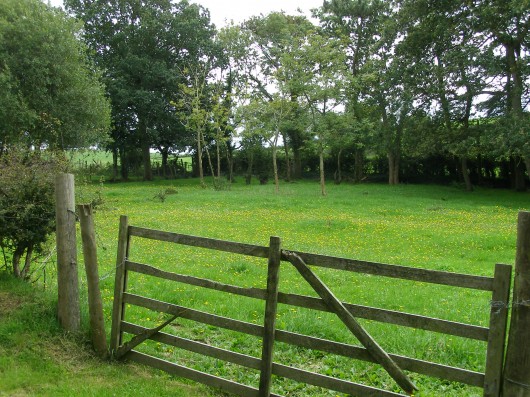 A 19th Century farm meadow in Northern Ireland
Ulster American Folk Park, Castletown, Northern Ireland
(Photo by Editor 20060904, free in public domain, click photo to enlarge) A 19th Century farm meadow in Northern Ireland
Ulster American Folk Park, Castletown, Northern Ireland
(Photo by Editor 20060904, free in public domain, click photo to enlarge)
.
In a native forest, old trees naturally die and saplings germinate from the seed of their parent trees. Native forests are living regenerating ecosystems.
But when humans destroy and disturb forest ecology, the forests change. When humans destroy complete forests and leave a few token shade-providing ‘paddock trees‘ in deforested paddocks, and livestock fertilize the thin fragile soils, humans completely deny forest ecological succession. Isolated trees are isolated trees, so they die. Dieback is one such outcome – suitably named; that is ‘Deforestation Dieback‘ as distinct from the disease ‘Phytophthora dieback‘.
And now some are crying foul out over losing these token ‘paddock trees‘, despite the loss of the entire original forest not getting a mention. This is such anthropocentric bias. The 19th Century William Wordsworth/John Constable pastoral romanticism of what the English countryside ought to look like became the colonial vision for Australia from 1788. It is this inherited notion of a ‘Colonial Bucolic Vista‘ and disturbingly it’s legacy still pervades Australian agricultural culture.
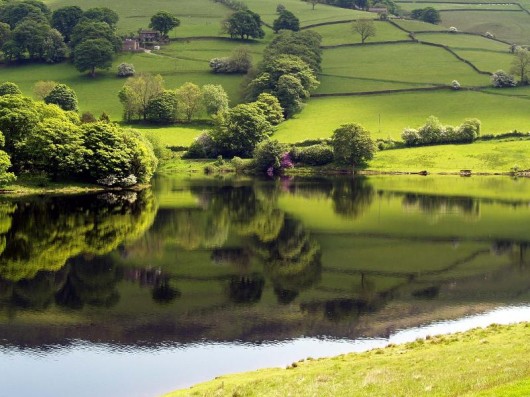 A classic vision of the bucolic English countryside
– where centuries of native heritage, agrarian culture and constant rainfall…permit. A classic vision of the bucolic English countryside
– where centuries of native heritage, agrarian culture and constant rainfall…permit.
.
‘Reversing a tree regeneration crisis’ (Dr Joern Fischer)
.
[Source: ‘Reversing a tree regeneration crisis’, by Dr Joern Fischer, Fenner School of the Environment and Society, ANU College of Medicine Biology and Environment, Summer 2009, Australian National University, ^http://news.anu.edu.au/?p=1725]
.
According to Australian National University (ANU) research published in the US-based ‘Proceedings of the National Academy of Sciences (2009):
.
‘Australia’s south-east temperate grazing region could be virtually treeless within decades.‘
.
‘The research team concluded that most of the trees scattered across millions of hectares of temperate grazing land in New South Wales and Victoria re old and close to death. Existing land management practices (Ed: aka broadscale deforestation) have prevented regeneration of young trees to replace them. The study pointed out that disappearance of ‘paddock trees’ would lead to loss of shelter for livestock, loss of habitat for birds and other wildlife, decreasing water infiltration and other detrimental flow-on effects over the entire ecosystem.
.
(Ed: Is there any trace of a native forest ecosystem on rural farm holdings? These shade tree deprived farmers didn’t complain when they were massacring Australian native forests. A treeless wasteland is the consequence of deforestation, you fools!)
.
Dr Joern Fischer from the Fenner School of the Environment and Society says:
“Under existing management practices, millions of hectares of grazing country, currently supporting tens of millions of trees, will be treeless within decades from now,” “And the loss of this tree cover is predicted to lead to massive declines in biodiversity and grazing productivity.” Dr Fischer’s Sustainable Farms research group has spent the last couple of years documenting the extent of the tree regeneration failure and has been investigating if the situation can be reversed by changing land management.
“Although clearing has largely stopped, tree cover continues to decline because many existing trees are dying of old age, and few young trees are regenerating,” says Fischer. “We studied a 1,000,000 hectare area in the Upper Lachlan catchment of New South Wales. Typical paddock trees are often over 140 years old, and in many locations, no young trees have regenerated for decades.”
ANU’s Dr Joern Fischer’s research found that ‘(native) trees are more likely to regenerate in unfertilised pastures under high -intensity rotational grazing than under conventional, continuous grazing. Fischer states that the study found that maintaining tree cover over vast areas cannot be done without Nature’s help – that is to say via natural regeneration. Therefore, farm ecosystems must become self-sustaining, allowing for natural tree regeneration while also providing an income to farmers.
.
(Editor: What brilliant insight! I hope the taxpayer didn’t fund such lay findings).
.
According to Tim Wetherill, ‘paddock trees‘ provide shelter for livestock, homes for native animals, barriers against soil erosion and a host of other benefits. They’re an icon of the Australian countryside’.
[Source: ‘Reversing a tree regeneration crisis’, by Tim Wetherill, ANU News, Summer 2009, ^http://news.anu.edu.au/?p=1725]
.
(Editor: “An icon of the Australian countryside” What colonial Pastoral Romanticism! What about the more important values of intact native forests before the farmers clearfelled them, burnt the remains and dragged the topsoil under plough?
.
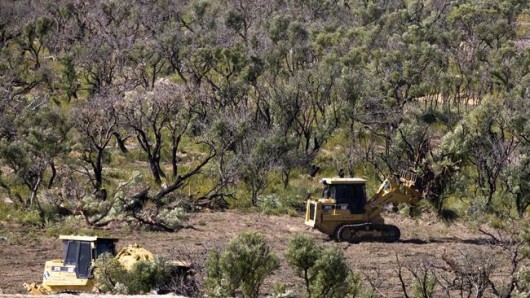 The decidedly browner, drier reality of Australia’s fragile disappearing native vegetation
Nature on the run: Hundreds of hectares of native animal habitat is bulldozed for a new housing development in Perth’s outer suburbs this year.
(Source: Perth Now, Photo by World Wildlife Fund, Australia 2009) The decidedly browner, drier reality of Australia’s fragile disappearing native vegetation
Nature on the run: Hundreds of hectares of native animal habitat is bulldozed for a new housing development in Perth’s outer suburbs this year.
(Source: Perth Now, Photo by World Wildlife Fund, Australia 2009)
.
Fischer’s report continues…
.
‘It’s long been known that paddock trees in much of Australia’s temperate grazing region are not regenerating. With every year we lose a few more as the old trees die but nothing is coming through to replace them. In recent years there’s been a growing realisation that the situation is rapidly evolving into a crisis.
“Our study identified a short list of management options for maintaining paddock trees,” says Fischer. “In some areas, natural regeneration is unlikely in the short term, for example because there are few parent trees, or because soil nutrient levels are high. In such areas, scattered trees can be planted with re-usable tree guards that protect individual trees from livestock – some pioneering farmers are doing this already. Another option is to temporarily exclude livestock from a paddock prior to re-seeding it and resting it for several years – an approach successfully used by Greening Australia in the Canberra region.”
“Our findings suggest that self-perpetuating farm ecosystems with farms trees can be created by applying high intensity rotational grazing with long rest periods, and by phasing out fertiliser use,” explains Fischer. “Even where these practices are adopted, changes in tree regeneration will not occur overnight. But unless significant changes in management are introduced now, old trees will continue to disappear, and opportunities for natural regeneration will continue to be lost.
“The future of Australia’s paddock trees depends on urgent and widespread management action. While mature trees still exist, they provide regeneration nuclei throughout the landscape, thereby offering a window of opportunity to reverse the tree regeneration crisis.”
.
Editor: Fischer’s quest to save ‘paddock trees’ is ecologically ‘penny wise, pound foolish’.
If Fischer’s aim is to have paddock trees regenerate so that farmers’ livestock may continue to have shade from the sun, then farmers can jolly well plant out their own shade trees – simple problem solved cheaply. Farmers could even propagate their own.
If Fischer’s aim is to maintain the 19th Century notion of the colonial bucolic vista, then he is disingenuous about forest ecosystem regeneration and ought to transfer from Science to Arts and study English Romanticism .
If Fischer’s aim is science-based forest ecosystem regeneration, then he should revisit the ANU Library and grab some appropriate books on forest ecosystem regeneration and realise that it is a tad more than about saving ‘paddock trees’).
.
Behold the Colonial Bucolic Vista! …derived from 18th and 19th Century Pastoral Romanticism…achieved by clearfelling, ploughing, fertilising, grazing and leaving a few token ‘paddock trees’.
.
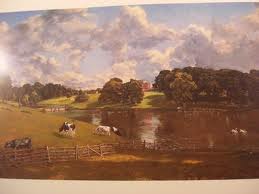 ‘Wivenhoe Park, Essex’
by 19th Century English Romantic painter John Constable ‘Wivenhoe Park, Essex’
by 19th Century English Romantic painter John Constable
.
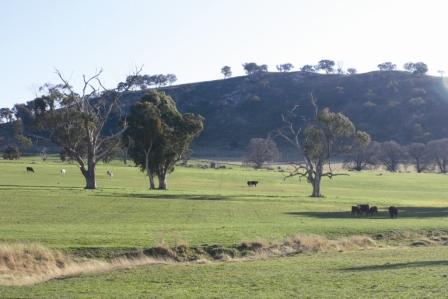 The colonial conversion of Australia The colonial conversion of Australia
.
‘Older paddock trees are dying at a rapid rate’ (M. Sheahan)
.
[Source: ‘Isolated Trees’, by M. Sheahan, Murray Catchment Management Committee/Department of Land & Water Conservation, Border Rivers-Gwydir – Catchment Management Authority, ^http://brg.cma.nsw.gov.au/index.php?page=isolated-trees]
.
‘When the land was cleared for grazing and agriculture, isolated ‘shade’ trees were left across the landscape. These isolated trees are, in many areas, all that remain of the native vegetation which once covered the land. As time passes, these trees are aging and dying, sometimes prematurely. If no action is taken to prevent their decline or replace them, we will be left with a treeless land – exacerbating land degradation and changing the face of a familiar landscape.
.
What are isolated trees?
.
Isolated trees can be defined as ‘trees around which the other components of a native vegetation community have been removed’. In some vegetation communities, like Open Woodland, the trees are naturally well-spaced. Trees in these communities are not considered to be ‘isolated’, if the vegetation community they are a part of generally remains intact.
.
The values of isolated trees
.
Isolated trees have a range of important values, including:
- Scenic and aesthetic value – isolated trees are, in many instances, what gives the Australian landscape its unique character. What would your area look like if all the isolated trees had gone?
- Shade – isolated trees provide shade for stock, enhancing livestock performance by preventing heat stress.
- Nesting sites for wildlife – many isolated trees are old, and commonly they have hollows. These hollows are used by many species of native animals, including birds, insect-eating bats and mammals. A third of all woodland birds require hollows for nesting, so these old trees may be the only place in the landscape where these species can breed. Hollows only begin to form in Eucalypts after about 100 years – the trees you plant today will take at least this long to replace the old isolated trees.
- Feeding sites for wildlife
.
A 300 year old Grey Box (Eucalyptus microcarpa) with a height of 20 metres and a diameter of 1.5 metres has a bark area of about 94 sq. metres. In comparison, a 20 year old tree which is 15 metres high with a diameter of 20cm has a bark surface area of just 9 metres. This extra bark (10 times more on the old tree) supports a diversity of insect life which can provide 10 times more food for insect eating birds. Healthy mature trees also produce more nectar, foliage and fruits than young trees, as the younger trees put more energy into growth in height.
.
Connective value
.
- Isolated trees can act like ‘stepping stones’, enabling birds and other species to move across the landscape.
- Fallen limbs – fallen limbs provide habitat for a range of ground-dwelling species.
- Nutrient cycling – the deep roots of isolated trees bring nutrients deep from the soil profile. These are then released at the surface in leaves, twigs, and branches that fall from the trees.
- Seed source – isolated trees can shower the site with seed, helping natural regeneration.
.
Why are they dying?
.
Isolated trees are, commonly, in decline and dying in some regions. This may be because they are old and reaching the end of their natural life, and they are not being replaced.
However, they may be dying prematurely, as a result of the change in land use around them. The changes which are affecting them can include:
- Soil compaction from stock
- Increased nutrient levels from stock and fertilisers
- Insect attack (the understorey, which provides the habitat of the insects natural predators, has been removed)
- Changes in the watertable
- Use of herbicides
.
.
Saving the ones that are left
.
Large trees were naturally once part of a functioning ecosystem that contained a range of other plant species and wildlife. Now they are sitting out on their own, surrounded by grazed pasture or crop-land. Their support mechanisms – the understorey which contained habitat for the predators of insects, neighbouring trees for protection and pollination – have been removed.
Ideally, to ensure their survival, we need to try and recreate the conditions that existed before. This means re-instating a ‘web of life’ that brings back the tree’s support system.
There are three actions that can help this – fence, revegetate and connect.
- Fence the trees, or clumps of trees, so that an area twice the size of their canopies is protected. If the ground cover is weedy, or is dominated by introduced pasture grasses, these will need to be controlled.
- Revegetate this area with locally native shrubs and groundcover. Allow the trees to regenerate from seed-fall.
- Connect these fenced clumps together and link them to larger areas of native vegetation, such as roadsides, stock routes and reserves.
.
In some situations, this may not be practical. It might cost too much, might take too long or may take too much land out of production. If so, consider the following:
- Avoid the use of fertilisers under the canopy and around the trees;
- Avoid cultivating under the canopy of the trees;
- Ensure herbicide doesn’t drift onto the trees;
- Don’t scorch the trees if burning off; and
- Leave fallen branches and sticks where they fall under the trees.
- Fencing is still important. Fence out the larger clumps where possible. If planning new fencelines, position them to provide protection for clumps of older trees.
.
Temporary fencing is one of the best solutions for managing isolated trees, to ‘give them a break’ and to encourage growth and regeneration. This should be twice the size of the canopy of the tree/s. After 2 or 3 years, young seedlings may have grown above browse height, so the fence can be moved to another tree or clump of trees.
.
The importance of groundcover
.
It might not seem important, but in all cases, the quality of the ground layer is a critical factor in:
- determining the health of isolated trees
- their ability to regenerate.
.
If the groundcover is dominated by native species, then older trees will more easily recover and regenerate. If the groundcover is weedy, or dominated by introduced grasses, recovery and regeneration will be difficult to promote. This is because weeds and vigorous introduced grasses like Phalaris intercept a lot of soil moisture before it can be taken up by the trees. The introduced grasses develop a dense sward, which suppresses tree regeneration. If the groundcover is weedy or dominated by introduced species, these species need to be controlled.
.
‘Intensifying agriculture – removal of isolated trees’
.
Advances in agriculture have seen the introduction of wider machinery and new agricultural systems. To adopt these new and more efficient systems it is sometimes felt necessary to remove some or all of the isolated trees in a paddock. The condition of isolated trees can decline, as branch tips die and, as condition declines, defoliation becomes intensive.
The process can be reversed if sound management is applied. However, if removal of trees is proposed to intensify agricultural enterprises, favour the retention of trees in better condition. Indeed, the advent of new systems and machinery, and the associated conversion of grazing land to crop land, and crop land to irrigation, has the potential to dramatically reduce the number of trees in the landscape. This would lead to undesirable consequences – land and water degradation, loss of wildlife, and the loss of a familiar and pleasing landscape.
However, with sound planning, it may be possible to maintain the values of isolated trees and encourage more efficient agricultural systems. Isolated trees fall within the definition of ‘native vegetation’ under the Native Vegetation Conservation Act 1997. Clearing of native vegetation (unless exempt) requires an application to be made to the Department of Land and Water Conservation.
The chance of any application being successful will be much greater where the landholder is willing to `trade off’ the removal of some isolated trees, in return for better protection and management of other isolated trees and native vegetation. In doing so, a ‘win-win’ outcome may be able to be achieved. Given that the condition of many isolated trees is rapidly declining, such an outcome can ensure that there is no ‘net loss’ of vegetation over the long term, and that the landholder can make his or her enterprise more efficient.
.
‘Developing a proposal for intensifying agriculture’
.
First, you will need to map your proposal on a property plan or aerial photograph. In doing so, identify where the development can take place with the least impact on native vegetation.
- Site the proposed development on the land with least number of trees, and on areas with trees of poorer condition;
- Site the proposed development on land where the ground cover is dominated by weeds or introduced grasses, rather than on land with native ground cover;
- Avoid areas of remnant native vegetation and habitat features such as watercourses and wetlands;
- Identify areas where clumps of trees, including old or large trees, can be retained;
- Maintain corridors of trees and native vegetation that connect to other patches of native vegetation both inside and outside the property. These corridors could connect clumps of isolated trees, follow natural features such as watercourses or ridges, or be retained along fencelines; and
- Propose better protection (i.e. fencing) and management of retained vegetation.
.
Second, arrange for a Catchment Manager or Vegetation Management Officer to discuss your proposal on site before you complete a clearing application. Ring you nearest Department of Land and Water Conservation office to arrange this.
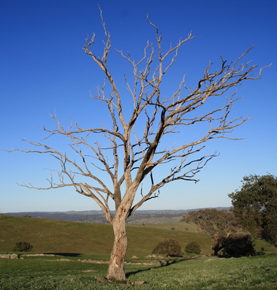 Once was a Shade Tree, once was a Forest
Now a dead reminder of self-righteous colonial exploitation
(Photo: Kate Sherren) Once was a Shade Tree, once was a Forest
Now a dead reminder of self-righteous colonial exploitation
(Photo: Kate Sherren)
.
References:.
.
- Cremer, K.W (1990) Trees for rural Australia. Inkata Press, Melbourne.
- DNRE (1990) Wildlife needs natural tree hollows. Land For Wildlife Note No. 6 Department of Natural Resources and Environment, Victoria.
- DNRE (1992) Old Trees for Wildlife. Land for Wildlife Note No. 18. Department of Natural Resources and Environment, Victoria.
- Nadolny, C. et al. (1997) A farmers guide to trees and bushland. North West Catchment Management Committee, Tamworth.
- Reid, N. (1996) Managing mistletoe. North West Catchment Management Committee, Tamworth.
- Wakefield, S. & Goldney, D. (1996) Assessing scattered farm trees, in Save The Bush Toolkit Charles Sturt University, Bathurst.
- Wakefield, S. & Goldney, D. (1996) Managing scattered farm trees, in Save the bush toolkit. Charles Sturt University, Bathurst.
.
Sunday, January 8th, 2012
[This article was first published on CanDoBetter.net 20091025 by Tigerquoll under the title ‘Southern Hairy Nosed Wombat – “destruction permits” issued in Sth Aust.’ It was sourced from the ABC ^http://www.abc.net.au/news/stories/2009/10/01/2701495.htm?site=news]
.
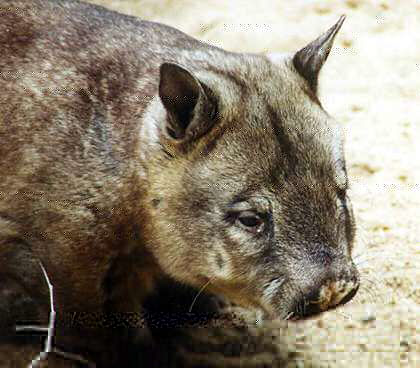 Southern Hairy Nosed Wombat (Lasiorhinus latifrons) Southern Hairy Nosed Wombat (Lasiorhinus latifrons)
.
2009:
“Farmers are illegally slaughtering thousands of wombats in South Australia, a nature group says. Brigitte Stevens from the Wombat Awareness Organisation says burrows of southern hairy-nosed wombats are being bulldozed or blown up on Yorke and Eyre Peninsulas and in the Murraylands.
She says farmers can get permits to destroy a few wombats, but that it not a licence to wipe out the entire population.
“There’s not enough or not good enough regulations on what actually happens to the wombat if those numbers are being killed,” she said. “Now I know it’s difficult because I know you need a lot of staff to be able to do that. But it’s really hard for us when we’re trying to stop people killing them illegally – if it’s allowed by the government through permits, how are we going to stop it?”
Ms Stevens wants the Department for Environment and Heritage (DEH) to act on evidence the group has gathered.
“We’ve also got evidence, photographic, and also I’ve kept all my correspondence with DEH, the RSPCA about places that we’ve reported that have ended up having destruction permits, but we’ve got evidence the animals are being buried alive, the entire population is being killed on that particular property,” she said.
Department for Environment and Heritage chief executive, Allan Holmes, says it will act when enough evidence is provided. “You need to know where it’s occurred, when it occurred, it’s about providing evidence that will stand up in a court of law,” he said. “Again the issue for me is at the moment these claims are largely unsubstantiated. “If the evidence is provided we will investigate them.”
Mr Holmes says mass killings with petrol bombs or bulldozing will not be tolerated.
“The only way that you can legally destroy a wombat is by shooting with a particular calibre rifle,” he said. “And, as I said, given the evidence we will prosecute with the full force of the law.”
.
2011: ‘Hairy-nosed wombats feel farmers’ wrath‘
[Source: ‘Hairy-nosed wombats feel farmers’ wrath’ , 20110420, ^http://www.cfzaustralia.com/2011/04/hairy-nosed-wombats-feel-farmers-wrath.html]
.
They’ve always been uneasy bedfellows, but now Hairy-Nosed Wombats – a rare and protected marsupial – are being slaughtered in large numbers by South Australian farmers as their numbers boom thanks to abundant rain and plenty of food.
.
Nearly 900 southern hairy-nosed wombats have been shot with South Australian Government sanction since 2006, and there are claims that many more have been slaughtered illegally.
.
The Government also has rules which state that any young wombats found in the pouch of a shot wombat should be killed by decapitation, as this achieves “a sudden and painless death”.
Sickeningly, Parliament has been told that apart from the official deaths, hundreds more wombats are being killed illegally by landholders across the state.
As well as being the state’s animal emblem, the wombat is classed as a vulnerable species, but farmers claim its burrows destroy their land and damage farm machinery.
Like badgers in the United Kingdom, wombats are much maligned by the farming community and are seen as a menace, copping the blame for everything from soil erosion and breaking the legs of cattle (from falling into wombat burrows) to spreading disease.
Official figures show that between January 1, 2006, and December 22 last year, 139 permits were issued for destruction of South Australian wombats.
.
Hairy-nosed Wombats?
The much rarer southern hairy-nosed wombat has larger ears than the common wombat, and its snout is coated with fine hairs, whereas the northern hairy-nosed wombat is presumed extinct in NSW.
The southern hairy-nosed wombat prefers dry, open country bu have become very rare, and until recently were thought to be extinct in NSW. They are currently listed as endangered.
A wombat can reproduce after it reaches two years of age. Mating occurs between September and December, and usually results in one offspring. The newborn wombat, which weighs only 1 g and is less than 3 cm long, has to crawl from the birth canal into the mother’s pouch. This pouch faces backwards, which stops dirt and twigs getting caught in it when the mother digs. The young wombat will stay in the pouch for between seven and 10 months.
Because of settlement and agriculture, wombats in most areas have been pushed into the rugged hills and mountains. As long as they remain in these areas, wild dogs and collisions with cars are more of a threat to these marsupials than landowners. However, because of their habit of wandering down to the flats to enjoy the tasty morsels growing there (knocking down fences on the way), they are sometimes killed by farmers.
.
[Source: ^ http://www.nationalparks.nsw.gov.au/npws.nsf/Content/Wombats]
.
‘Wombat Awareness Organisation‘
‘The Wombat Awareness Organisation (WAO) is a non-profit organisation specialising in large scale rescue, rehabilitation and conservation of the Southern Hairy Nosed Wombat (Lasiorhinus latifrons).
The Wombat Awareness Organisation is playing an instrumental role in preventing unneccessary suffering of the wild population of Southern Hairy Nosed Wombats in hope to conserve this incredible little Aussie for future generations.
When WAO established itself in the Murraylands of South Australia in 2007 we were overwhelmed at the lack of services and protective rights offered to SA’s faunal emblem. Battling the effects of drought and global warming, Sarcoptic mange, habitat destruction, vehicular accidents and culling both legal and illegal it was obvious that this species was in trouble. Getting back to basics and finding simple, productive alternatives of drought relief, mange management and coexistence strategies have become the main focus of the organisation by aiming to protect these beautiful wombats from suffering and minimise the need for them to come into care.’
.
Read More: ^http://www.wombatawareness.com/
.
‘Going Khaki’:
Government wildlife protection has long been a joke and so much so that ‘Government wildlife protection‘ has become an oxymoron. Community frustration is obviously a boiling point at learning about an endangered wildlife species being poached by selfish farmers for their own ends.
If there were a fund for taking out poachers of wildlife I would gladly donate to it.
If it were legal to shoot wildlife poachers I would be amongst the first to enlist. It is legal to shoot wildlife poachers in parts of Africa where it is needed…
.
‘Among Africa’s Eco-Mercenaries’
[Source: ‘Among Africa’s Eco-Mercenaries’, by Nicole Davis, National Geographic, 200210, ^ http://www.nationalgeographic.com/adventure/0210/life.html]
.
‘They’re trained to kill, with orders to shoot on sight. Could they be the saviors of Africa’s wildlife?
Writer Tom Clynes went deep into the Central African Republic to find out. Here he reveals the stories behind his new article, “They Shoot Poachers, Don’t They?”
This year Wyoming conservationists took their battle overseas into the savanna of the Central African Republic. With the permission of President Ange-Félix Patassé to shoot on sight, the group is raising a militia to patrol the eastern third of the African country for poachers.
Writer Tom Clynes spent nearly a month with the hired guns in this latest effort to stop the bush-meat trade, perhaps the pre-eminent threat to African wildlife today. The assignment was as complicated as it was fascinating.
“The good stories begin with intriguing questions. And in this case the questions were complicated and quite epic. You had a bunch of Americans who had basically convinced a leader of a Third World country to let them raise an army and take over a third of the country with shoot-on-sight authority,” says Clynes. “I had a good idea how I felt about this kind of thing: Killing is wrong—end of argument.”
.
‘They Shoot Poachers, Don’t They?‘
[Source: ‘‘They Shoot Poachers, Don’t They?”, by Tom Clynes, National Geographic, 200210, ^http://www.nationalgeographic.com/adventure/0210/story.html#story_1]
.
In the heart of central Africa, marauding bands of bush-meat hunters are terrorizing villages and slaughtering wildlife to the brink of extinction. Now a family practitioner from Wyoming has decided to recruit his own army to stop them.
The story, as I first heard it, had the zing of a Hollywood pitch: Led by a soft-spoken doctor, a band of American conservationists had persuaded the president of the Central African Republic to let them raise a militia and take over the eastern third of the Texas-size country. Their mission was to drive out the marauding gangs of Sudanese poachers who were rapidly wiping out the region’s elephants and other animals.
Their authority: ‘Shoot on sight’
No one had been killed yet when I arrived in Bangui in early March. Throughout the dilapidated capital, signs of a November coup attempt were still fresh: Bullet divots scored the bricks of the Tropicana Club, and a curfew remained in effect. A detachment of Libyan paratroopers hulked in front of the mansion of President Ange-Félix Patassé, who had been bailed out, again, by his friend Muammar Qaddafi.
Most of the fighting had taken place in the northern reaches of town, where the American group, Africa Rainforest and River Conservation (ARRC), had rented a gated compound. As I approached the large whitewashed porch, it struck me that ARRC was well prepared for another flare-up. Scattered among the wicker furniture were several men in fatigues, a couple of AK-47s, a grenade launcher, and a very excited chimpanzee.
Dave Bryant, a 49-year-old South African who had been hired in August to lead the militia, extended his hand. “Welcome to bloody paradise,” he said. He introduced a slight, 26-year-old Iowan named Michelle Wieland, who was in charge of ARRC’s community-development component, and a thin 35-year-old named Richard Hagen, who had flown up from South Africa to help with security.
“And the little fellow jumping up and down is Commando,” said Bryant. “We rescued him from a Sudanese trader, and to show his appreciation he’s been crapping all over our floors.”
Bryant’s face seemed custom-assembled for bad-ass impact. Beneath a clean-shaven scalp, a towering forehead descended into a deep ravine of a scowl line, bridged by wraparound sunglasses. An expansive Fu Manchu mustache arched around a loaded cigarette holder, which dangled expertly from one side of his mouth.
“I guess you’ve heard that we’re in a bit of a cock-up,” he said. “We’ve been stuck in this shit-hole for five months now, trying to get out into the bush to do a reccy [reconnaissance] before the rains hit. We’re waiting for gear, we’re waiting for money, and we’re waiting for vehicles. And we’re waiting for people in this zoo they call a government to do something other than put their bloody hands out.”
The three were eager to hear about my meeting that day with the American ambassador, Mattie Sharpless. Sharpless had recently arrived in Bangui, and I had asked her what she knew about ARRC.
“The rumor is that they’re hiring South African mercenaries and diverting funds into diamond ventures,” Sharpless had answered.
Wieland winced when I relayed the quote, but Bryant smiled and leaned back in his chair. “Yes, well. We South Africans don’t usually like to use the term ‘mercenary.’ We prefer to say ‘playing at soldiers on a privately employed basis.'”
.
Tags: animal cruelty, badgers, conservation, Don't They, Eco-Mercenaries, farmers, going khaki, Shoot poachers on sight, South Australia, southern hairy-nosed wombat, They Shoot Poachers, wildlife protection, wombat, Wombat Awareness Organisation
Posted in 21 Going Khaki!, Threats from Farming, Threats from Poaching and Poisoning, Wombats | No Comments »
Add this post to Del.icio.us - Digg
Saturday, January 7th, 2012
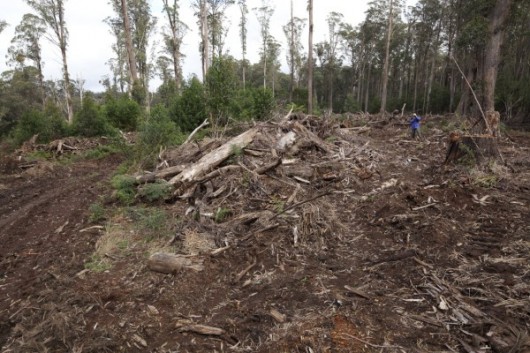 Cathcart State Forest (NSW) being logged in 2011
[Source: Australian Forests and Climate Alliance ^http://forestsandclimate.net/newsouthwales] Cathcart State Forest (NSW) being logged in 2011
[Source: Australian Forests and Climate Alliance ^http://forestsandclimate.net/newsouthwales]
.
Most of Australia’s native vegetation cover, over 75% of that predating the 1788 Colonial Invasion, has been ‘cleared’ – a euphemism for deforested, logged, destroyed, killed.
Today, as one travels around Australia and sees vasts areas of unproductive, degraded, denuded and abandoned farmlands – one questions why destroy more fragile environment? Yet the exploitative bastards are still hell bent on killing more native forest and bushland, even though they can’t properly manage the ‘already ‘cleared’ lands they’ve got. It is a short sighted insatiability, harking to a 19th Century ‘old blighty’ mindset of taming the land. It is deluded thinking that just because the native vegetation is green and looks fertile that it can be replaced for pasture and cropping and that new cleared land will be any different to that already cleared.
The Liberal-Labor governments and their rural National mates haven’t given a toss throughout the entire 20th Century and still couldn’t give a toss.
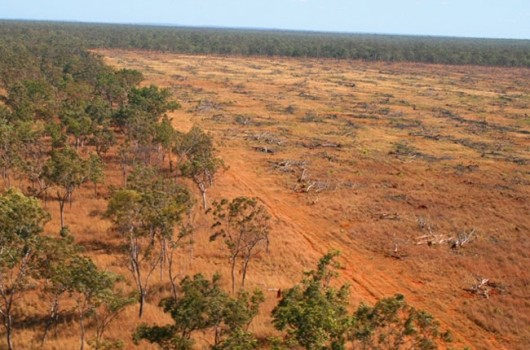 Recent land clearing in the Daly River catchment area
Northern Territory, Australia.
Photo: Environment Centre NT Recent land clearing in the Daly River catchment area
Northern Territory, Australia.
Photo: Environment Centre NT
.
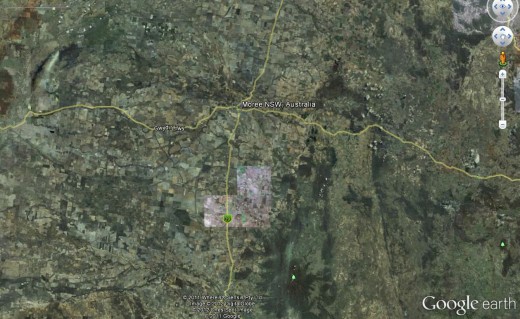 Moree region New South Wales – mainly deforested
Visit Google Earth and zoom into any area of NSW and see that most of it has been deforested
(click image to enlarge) Moree region New South Wales – mainly deforested
Visit Google Earth and zoom into any area of NSW and see that most of it has been deforested
(click image to enlarge)
.
Still across Australia in 2011, thousands of hectares of native forests continue to be deforested – albeit for farming, logging and development, or just bizarre bushfire abandonment. Not only is this occurring on private land, but in State Forests, which most people think are protected. Native forests on land are being cleared branded by State governments as ‘State Forests’ are simply not protected.
The native trees, flora and fauna are not protected from logging, bushfire, State-sanctioned arson (aka ‘hazard reduction‘), State napalming (aka indiscriminate ‘hazard reduction‘), indiscriminate State aerial poisoning with 1080, wildlife poaching, 4WD hooning, trail bike hooning, or even backpacker murdering. The watercourses (and the interconnected groundwater aquifers), that flow through State Forests are not protected from fishing, stormwater run-off, mine tailing contamination, farm pesticide and herbicide, industrial pollution.
.
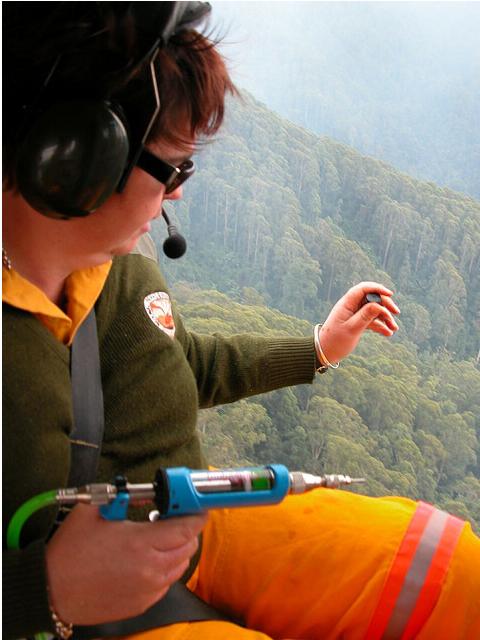 Helicopter Aerial Incendiary
Over Bindarri National Park, 20km south-west of Coffs Harbour, New South Wales
Yes, even our National Parks and Wildlife Service sets indiscriminate fires to National Parks! Helicopter Aerial Incendiary
Over Bindarri National Park, 20km south-west of Coffs Harbour, New South Wales
Yes, even our National Parks and Wildlife Service sets indiscriminate fires to National Parks!
.
For the likes of taxpayer funded government industrial loggers ‘State Forest’ is a euphemism ‘for not logged yet‘. This applies to the likes of Forestry Tasmania, VicForests, Forests NSW, Forestry SA (spot the naming trend), as well as the more aptly Queensland Department of Primary Industries and Fisheries, and likewise the Forest Products Commission of Western Australia.
It seems that doesn’t matter whether there is proof that there is an endangered and protected species such as the Long-Footed Potoroo in the Cann Valley State Forest or Drummer State Forest in Victoria, or protected Koalas in the Murrah/Mumbulla State Forests of New South Wales, or three identified endangered species, the wedge-tailed eagle, the swift parrot and the wielangta stag beetle in Tasmania’s Wielangta State Forests, the Liberal-Labor governments of those States turn a blind eye to deforestation.
It is only when self-funded local communities take the respective government logger to the Supreme Court and win that logging stops momentarily, such as in the recent Victorian Supreme Court case Environment East Gippsland Inc v VicForests [2010] VSC 335. In 2006, the Victorian State Government committed to increasing the conservation parks and reserves within the broader Brown Mountain area. Disregarding its elected master and ignoring any concerns for the ecological Precautionary Principle, State industrial logger VicForests, got stuck in with its mechanical clearfelling of old growth forests in the Brown Mountain area.
Not-for profit group Environment East Gippsland (EEG) self-funded and obtained numerous studies of the area indicated the presence of important threatened and rare species. EEG requested the Minister for Environment and Climate Change, Gavin Jennings, to make an interim conservation order to conserve critical habitat of the endangered Long-footed Potoroo, Spotted-tailed Quoll, Sooty Owl, Powerful Owl and Orbost Spiny Crayfish at Brown Mountain. Even then, the Minister for Environment and Climate Chang did not grant a conservation order, but instead increased the conservation area surrounding Brown Mountain. It took the overriding legal authority of the Supreme Court to stop the Victorian Government and its delinquent logger trashing protected old growth habitat.
 Victorian Labor Minister for Environment (etc), 2007-2010 Victorian Labor Minister for Environment (etc), 2007-2010
.
In March 2010, Forests NSW began controversial logging operations in the Mumbulla State Forest, south of Bermagui on the state’s far south coast. Despite being criticised, after a recent survey identified the forest as a key colony for the region’s remaining koala population, Forests NSW Regional Manager Ian Barnes says the logging must go ahead across 240 hectares of the forest, in order to satisfy a supply agreement with the timber industry.
 Deforestation is all about lining ones pockets out of ecological wanton exploitation
It’s a ‘wam bam thank you mam’ approach no different to what the Vikings did to the British in the eight Century.
Colonial Australians and their descendants are doing the same to Australian ecology in the 19th, 20th and 21st Centuries. Deforestation is all about lining ones pockets out of ecological wanton exploitation
It’s a ‘wam bam thank you mam’ approach no different to what the Vikings did to the British in the eight Century.
Colonial Australians and their descendants are doing the same to Australian ecology in the 19th, 20th and 21st Centuries.
Mr Barnes says the logging will not affect the koala habitat. “We’ve taken quite some effort to avoid any possible conflict there,” he says. “As anybody who reads the recent report will know, the koalas have been found in the eastern side of the forest, and our logging is planned for the western part, as far away as we can get from the koalas.”

Despite assurances, anti-logging campaigners have organised a vigil in the forest in an attempt to stop the logging. Conservationist Prue Acton says the activity will devastate the koala population.
“Why risk the only healthy koala colony left in the far south coast. For what? “ she said. “95% of what is going to be logged is going to end up at the Eden woodchip mill, be shipped to Japan for cheap copy-paper. What a disgrace.”
The Greens MP Lee Rhiannon says the Premier should put the protection of koalas ahead of the interests of logging companies. “The New South Wales Government has refused to end logging in the south east native forest but they should step in and stop the destruction of the koala habitat,” she said.
[Source: ‘Logging begins near key koala habitat‘, ABC, 20100330, ^http://www.abc.net.au/news/stories/2010/03/30/2859615.htm?site=southeastnsw]
.
‘Loggers are clearing bushland at rising rate‘
[Source: ‘Loggers are clearing bushland at rising rate’, by Ben Cubby, Sydney Morning Herald, 20111221, ^http://www.theherald.com.au/news/national/national/general/loggers-are-clearing-bushland-at-rising-rate/2399764.aspx?storypage=0]

The amount of bushland being cleared by logging in NSW soared last year to the highest level since state-wide records began in 1988. An area equivalent to 138,400 football fields was cleared for crops, forestry or infrastructure, says a government report.
The Office of Environment and Heritage said the rise in logging was probably cancelled out by regrowth, leading to no net loss of trees, though its most recent survey took place in 2008, before the land clearing spike. It said the reasons for the logging increase were unclear.
”[The] most likely factors relate to market demand and favourable climatic conditions and [they] can be expected to fluctuate over time,” a department spokesman said. ”It is also possible that recent changes in forestry methods are more readily detectable by satellite monitoring.”
Environment groups said the annual vegetation report was evidence that logging companies were operating in an unrestrained manner.
Bushfires remain the biggest destroyer of forests in the state, leading to a net loss of 48,300 hectares in 2010, the report said.
.
But logging activities now come a close second, accounting for the removal of 42,700 hectares of trees in 2010. This is up from 31,000 hectares the previous year, and an average of about 21,000 hectares a year since 1988.
About 21,200 hectares of bushland was cleared in 2010 to make new areas for crops and grazing, while 5300 hectares were cut down to make way for roads, factories and housing.
”The NSW government is currently conducting a review of native vegetation controls,” said the chief executive of the Nature Conservation Council of NSW, Pepe Clarke. ”They should take this report as a warning – what is required are stronger land- clearing laws that do more to protect the environment, not weaker ones.”
The Wilderness Society said the government had ”failed in its promises to restrain land clearing, resulting in rapid and accelerating degradation of wildlife habitat and water catchments.”
The most recent State of the Environment report found that there had been no net loss of ”woody cover” across NSW between 2003 and 2008.
”This is because, although clearing has occurred over that period, there has also been an equivalent amount of regrowth including government sponsored environmental and forestry planting programs conducted by private landholders and state forests, within crown forests areas,” the department said.
”Notwithstanding no net loss over the whole state, some regions have experienced net declines in woody cover.”
The report uses the international definition of ”woody cover”, which includes land at least 20% covered by the crowns of trees higher than 2 metres, a description which would include relatively open country.
The introduction of a satellite monitoring system for land clearing last year appears to have increased the level of prosecution for illegal land clearing on private property. On crown lands, the number of prosecutions has increased threefold, from a low base, since 2007.
In 2010, the government received 471 reports of suspected illegal land clearing.
.
‘Landowners sent satellite images identifying land clearing‘
[Source: ‘Landowners sent satellite images identifying land-clearing’, NSW Department of Environment (etc), Media release: 14 May 2010, ^http://www.environment.nsw.gov.au/media/DecMedia10051404.htm]
.
NSW Department of Environment Climate Change and Water (DECCW) today began a high tech education campaign to encourage compliance with native vegetation laws by sending letters to landholders including before and after satellite pictures identifying land clearing.
DECCW Director-General Lisa Corbyn said the letters were part of an ongoing education program to encourage compliance with the laws and inform landowners of the proper channels available to them if they want to clear native vegetation.
“We’ve been using satellite technology for some time to identify changes in vegetation cover that may warrant further investigation,” Ms Corbyn said.
“Now we are also using the technology as an education tool. From today, advisory letters will be sent to landowners including before and after satellite pictures showing that vegetation has been cleared on their land.”
Ms Corbyn said the letters aim to inform to the landowner that the satellite imagery has picked up that vegetation had been cleared and highlight the proper channels available to them under the legislation to allow clearing of native vegetation, such as property vegetation plans.
The letters support other tools used by DECCW to encourage compliance with the legislation, including strategic investigations, prosecutions, penalty notices, stop work orders, remedial directions, warning and advisory letters.
The letter also alerts landowners to incentive funding available to restore and protect native vegetation on their properties.
The Native Vegetation Act was introduced in 2003 to bring an end to broadscale land-clearing in NSW. Since then, more than 400,000 hectares of native vegetation has been conserved or rehabilitated on private land through property vegetation plans (PVPs) and 1.6 million hectares has been managed for thinning and invasive native scrub management.
.
Over 60 % of the native vegetation in NSW has been cleared, thinned or substantially disturbed.
.
The impacts of native vegetation clearing have included the extinction of 77 plant and animal species, soil erosion, increased dryland salinity and a decline in water quality.’
.
2003: ‘Clearing rate in NSW 116,000 to 216,000 hectares per year: NSW Govt report’
[Source: ‘Clearing rate in NSW 116,000 to 216,000 hectares per year: NSW Govt report’, by Stephanie Peatling, Environment Reporter, Sydney Morning Herald, 20031117, ^http://www.sydneyalternativemedia.com/id64.html]
.
The equivalent of up to 200,000 football fields may be illegally stripped of native trees and grass each year in NSW, figures suggest.
The first estimates on the extent of the clearings, which the Department of Natural Resources field staff prepared for the Government’s vegetation taskforce, suggest the figure could be as high as 100,000 hectares a year. The figures show between 150,000 hectares and 560,000 hectares were illegally cleared between 1997 and 2002.
The advice is the first official guess at NSW’s illegal clearance levels. The highest rates are in the Barwon, Central West and Far West regions where much of NSW’s remaining native vegetation is located.
The figures have shocked environmentalists, who stress the urgency of making changes to the state’s natural resource management system, which Parliament is debating this week.
A Wilderness Society campaigner, Francesca Andreoni, said: “The new system needs to be fair to everyone, particularly farmers doing the right thing.
“The shocking extent of illegal clearing confirms the urgent need for the Government to implement its decision to end broadscale clearing.”
Figures recording the rate of illegal land clearing each year are almost impossible to compile because it so hard to charge people who breach native vegetation laws. There is also a complicated system of exemptions which allow people to clear land for purposes such as maintaining fire access trails.
Monitoring illegal clearing is potentially dangerous for departmental compliance officers. After reports of illegal clearing earlier this year on a property near Nyngan, in the state’s west, department officers were prevented from entering the property by an angry crowd of up to 150 people.
.
When the amount of land illegally cleared is added to land that is legally approved for clearance, the department estimates between 700,000 hectares and 1.3 million hectares of land were cleared between 1997 and 2002.
.
The figures suggest clearing was faster than the Department of Natural Resources’ previously admitted figure of about 60,000 hectares a year. That figure would give NSW the second-highest clearing rate in the country behind Queensland.
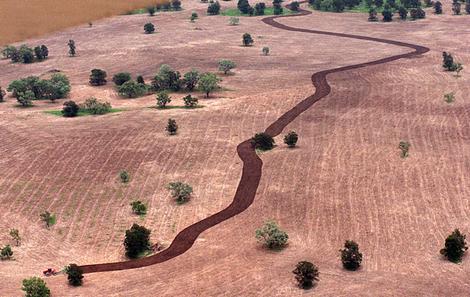
Debate on the Government’s package to overhaul native vegetation laws, based on an election promise to end broad-scale clearing, will take place this week. Last month the Premier, Bob Carr, announced a $406 million deal between farmers and environmentalists to end broad-scale clearing.
Most of the money is expected to go towards such things as tree planting and fencing waterways to help counter salinity and erosion. But local authorities may also compensate farmers for not clearing land. Clearing will still be allowed where it is deemed environmentally necessary.
Under the new system, natural resource management is being overhauled. Thirteen catchment management authorities will replace 19 catchment management boards, 20 regional vegetation committees and 33 water management committees.
Scientists often name land clearing as one of Australia’s most urgent environmental concerns. It contributes to soil salinity, loss of biodiversity and greenhouse gas emissions because carbon dioxide is released into the atmosphere when the cleared timber is disposed of, usually through burning.
.
‘Green groups attack logging growth’
[Source: ‘Green groups attack logging growth’, by David Bancroft, My Daily News, 20111229, ^http://www.mydailynews.com.au/story/2011/12/29/green-groups-attack-logging-growth/]
.
Environment groups have banded together to criticise the level of logging occurring in New South Wales. The Nature Conservation Council, The Wilderness Society, National Parks Association, the Northern Inland Council for the Environment and the North Coast Environment Council have issued a joint warning that iconic and endangered species are being threatened by land clearing.
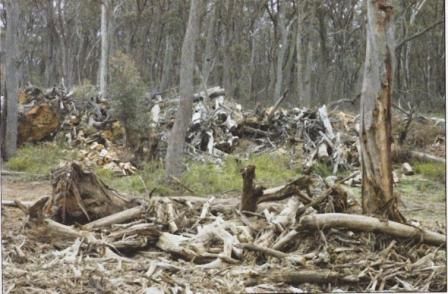 Illegal deforestation for fire wood, near Taralga, on the western edge of the Blue Mountains
Source: ^http://www.orchidsaustralia.com/article_%20conservation_no3.htm Illegal deforestation for fire wood, near Taralga, on the western edge of the Blue Mountains
Source: ^http://www.orchidsaustralia.com/article_%20conservation_no3.htm
.
In a joint press release, the groups said the NSW annual report on native vegetation released by the Office of Environment and Heritage (Ed. yet another money wasting name change) this month showed 2009/10 was the “worst year on record for clearing of native bushland”.
.
The Wilderness Society campaigns manager Belinda Fairbrother said the report showed that in 2009/10 an area equating to 138,400 football fields was cleared for crops, forestry or infrastructure.
.
“This is higher than any other year since records commenced in 1988 and shows the NSW Government has failed in its promises to restrain land clearing, resulting in rapid and accelerating degradation of wildlife habitat and water catchments,” she said.
North Coast Environment Council president Susie Russell said the report made a sad end to the International Year of Forests.
“The area cleared for forestry in 2009/10 was almost five times greater than it was in 1988/89,” she said.
“It reveals a massive increase in the rate and intensity of logging in NSW, which will be causing untold damage to the extraordinary high diversity forests of north-east NSW.”
Nature Conservation Council chief executive officer Pepe Clarke said land clearing was recognised as the single greatest threat to wildlife in Australia.
“It causes the death of birds and animals, the extinction of species, leads to the poisoning of soils from salinity and makes a major contribution to global warming,” he said.
.
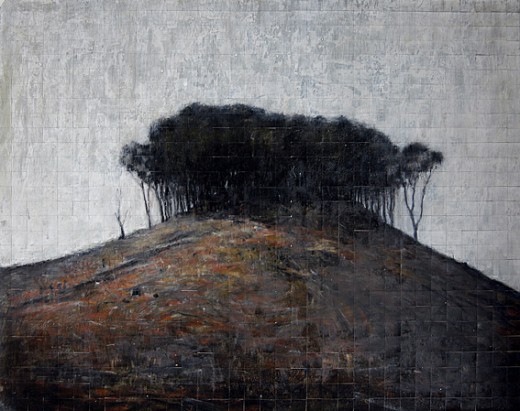 The Liberal-Labor Party ‘Island Vision’ for Australia’s State Forests
‘The Hill’ (Penrose State Forest, NSW) 2007, drawing by James King The Liberal-Labor Party ‘Island Vision’ for Australia’s State Forests
‘The Hill’ (Penrose State Forest, NSW) 2007, drawing by James King
^http://www.jamesking.com.au/drawings.html
.
Tags: 1788 Colonial Invasion, Cathcart State Forest, deforestation, Eden woodchip mill, fire wood, Forests NSW, Google Earth, hazard reduction, Helicopter Aerial Incendiary, Island Vision for Australian State Forests, koala habitat, land clearing, Logging, Long-footed Potoroo, Murrah/Mumbulla State Forests, not logged yet, Orbost Spiny Crayfish, Powerful Owl, precautionary principle, Sooty Owl, spotted-tailed quoll, State-sanctioned Arson, VicForests, Wielangta State Forests
Posted in Koalas, Owls, Quolls, Threats from Bushfire, Threats from Deforestation, Threats from Farming | No Comments »
Add this post to Del.icio.us - Digg
Monday, December 19th, 2011
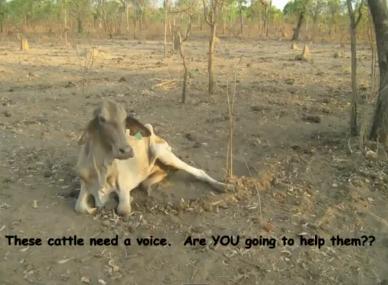 This is not Ethiopia…it is Mataranka Cattle Station in 2010 This is not Ethiopia…it is Mataranka Cattle Station in 2010
Northern Territory, Australia
[Source: ^http://www.youtube.com/watch?v=pMX7fAMSkXA]
.late
This Editor recalls travelling as an impressionable backpacker by chance through Mataranka some years ago in 1983, then again on a career mission in 1990. The first trip was a ‘gap year‘. The second trip was a personal mission driving from Melbourne via Adelaide, up the Stuart Highway, stopping at Victoria River Downs Station and ultimately arriving at Kununurra. My ambition was to acquire a commercial helicopter license, low-level endorsement and associated cattle mustering experience. It was secured through locally connected ‘Golden West Helicopters’ (Slingsby Helicopters) offering an ‘introductory‘ advantage to a parochial profession closed to outsiders. This was the aviation career lure, albeit achieved after $45,000 dispersed, licence acquired but leading into the 1991 recession then Prime Minister Paul Keating said ‘we had to have‘.
The benefits of hindsight they say, or life’s lesson.
It is an extremely hot place in inland northern Australia about 400 km south of Darwin characterised by grassy woodland savannah. Toward the end of the Dry Season, temperatures can exceed 50 degrees celsius in the sun. While the Brahman cattle breed has been long bred across northern Australia because of the breed’s adaptability to hotter climates, no animals can withstand such extreme heat. But worse, no animal can withstand starvation and abuse at the captive hand of cruel sadistic handlers.
At Mataranka Cattle Station, a 77,000 hectare commercial cattle station, between 2008 and 2010, hundreds of cattle as well as horses were cruelly treated, allowed to suffer and die from criminal neglect and starvation. Station Manager Ian Gray was in charge at the time. He was let off by the Northern Territory Government as part of a government cover up to protect the reputation of the cattle industry and of Charles Darwin University which controlled the cattle station. The instances of animal cruelty are perhaps the worst in Australia’s history. They came a time when many Australians become horrified by the footage of inhumane treatment of cattle in Indonesian abattoirs after being exported live from northern Australia.
The Australian beef cattle industry is promoted by the Northern Territory Government as one of Australia’s ‘premium export industries.’
At what cost?
.
“In northern Australia, beef cattle are raised on very large properties (stations) where they graze on native pastures and bush.”
~ CDU website
.
Not only is cattle farming in northern Australia treating northern Australian wilderness as one big cattle paddock and trampling the last remnants of savannah ecosystems, the cattle industry in northern Australia is savagely cruel, immoral and should be shut down. It is no surprise that the main buyer of cattle in northern Australia, Indonesia, is winding down the export trade. Indonesia has been very open about it becoming self-sufficient for years. Those involved in the live cattle export trade have worked themselves into a dead end industry. Based on the following account at Mataranka, the live cattle trade can’t end soon enough.
.
Update (20120103):
It has come to the editor’s attention through a reliable party that the station manager of Mataranka at the time, Ian Gray, has formally rebutted the NT Ombudsman’s report saying that he never maltreated cattle at Mataranka Station. It is anticipated that further insight into this matter will serve to provide a more balanced account of what happened. This article essentially reproduces already reported material from other sources, including the NT Ombudsman and the ABC, which are widely regarded as reliable sources, as well as video footage of the condition of the cattle.
The aim of the article is to raise general awareness of the particular animal cruelty reported at Mataranka Station over several years, plus more broadly of the unethical nature of the cattle industry in northern Australia. We are interested not just in raising awareness of animal cruelty and injustice against wildlife, but changing human behaviour and culture to eradicate cruel and harmful practices. We would like to pursue this subject with an aim of contributing to constructively change to the animal handling culture, harmful farming practices, policies, practices, laws and funding of government, industry and university so as to improve the triple bottom line standards of agriculture across northern Australia. We will be pleased to publish information that helps achieve these ends.
.
.
.
Mataranka Death Campl
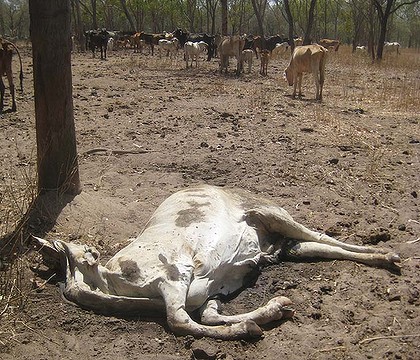
“At Mataranka Station from about August 2009 to December 2009 animals died from malnutrition, lack of water and others were destroyed. In many cases, livestock were tick infested, emaciated, thirsty, dehydrated, victims of attack from wild animals and meat ants. Some would have died an agonising death and those that survived were distressed, probably for months.”
.
[Source: Executive Summary, p.4, Volume 1, REPORT OF INVESTIGATION INTO THE TREATMENT OF CATTLE & HORSES AT CHARLES DARWIN UNIVERSITY MATARANKA STATION, by NT Ombudsman, 2010]
.
Northern Territory’s Charles Darwin University’s (CDU) teaching facility at Mataranka Station has been found to have condoned and ignored widespread animal cruelty, mistreatment, neglect, suffering and starvation of the Station’s 4500-strong herdover a three year period from 2008-2010.
Worse than that, Charles Darwin University in cahoots with the Labor Northern Territory Government have tried to excuse the treatment and sweep the matter under the carpet. The CDU website on 1st February 2010 tried to suggest excuses such as the photos being ‘taken toward the end of the Northern Territory dry season‘, that ‘only a small proportion were in extremely poor condition‘, that cows were ‘calving out of season‘ – the cows fault, and dismissing the abuse simply as ‘poor herd management‘.
It claims CDU acted as soon as it became aware of the problem in September 2009. Crap!
[Source: ^http://ext.cdu.edu.au/newsroom/a/2010/Pages/100201-Mataranka-Station-claims.aspx]
.
Charles Darwin University students exposed to the cruel animal treatment were disgusted, took photos, formally complained to the authorities (which did stuff all) and resigned from the university in disgust. University students training to work in the pastoral industry said they were distressed after seeing animals suffering and dying.
One witness observed carcasses being bulldozed into a mass grave and set alight after animals were starved and left to die on a university-run cattle station. Some of the animals were so weak they were eaten by meat ants or ripped apart by dingoes, wild dogs and feral pigs. Cattle were tick-infested, emaciated and dehydrated while others were too weak to stand and may have spent days on the ground before dying. Still-alive cattle were seen with their bowels ripped out by dingoes, unable to stand. The hoof of one horse fell off, which only occurs after a long period of neglect and months of suffering.
“Some [animals] would have died an agonising death and those that survived were distressed, probably for months,” Ms Richards said.
[Source: ‘Witness tells of mass animal grave‘, Lindsay Murdoch, Mataranka, Northern Territory, 20110425, ^http://www.smh.com.au/environment/animals/witness-tells-of-mass-animal-grave-20110424-1dt35.html]
====
Charles Darwin University’s Katherine Campus still offers a ‘Certificate III in Agriculture (Beef Production)‘ mainly out of Mataranka Station. The campus focuses on agricultural training for Vocational Education and Training (VET) courses, Australian Apprenticeships and traineeships in agriculture. Programs include the nationally-accredited Agriculture & Rural Production VET / TAFE Training Packages. Two-to-five day workshops in rural production skill areas including welding, vehicle maintenance, operating tractors, ride-ons and 4WD driving are also offered by the Katherine campus.
‘Do you want to work in an exciting, challenging industry that involves handling animals and machinery with extensive out-of-doors work? the beef cattle industry may be for you.‘… it promotes.
.
[Source: ^ http://www.comparecourses.com.au/Course/certificate-iii-in-agriculture-beef-production-50670.htm]
.
.
‘Sorry Saga’
.
This article has been prompted by the re-running of the ABC TV’s Landline programme, ‘Sorry saga‘ which was first broadcasted 20110727, and reported by Prue Adams
[Watch Landline Video: ^http://www.abc.net.au/landline/content/2010/s3276556.htm] – still available at the time of publishing.
We’ve seen and heard a fair bit lately about animal welfare. With most of the outrage aimed at the handling of Australian cattle exported live to Indonesia. But today, we’ll show a shocking case of cruelty that occurred right under the noses of government and university authorities in the Northern Territory.
It’s a sorry saga of mismanagement and neglect that’s dragged on for nearly two years. And despite a high-level report recommending prosecution, no one has ever been charged.
Prue Adams prepared this special report for Landline and we should warn some viewers may find images in this story distressing.
TOBY GORRINGE (VOICEOVER): In case you’re unaware, I wish to draw your attention to the serious nature of the animal welfare state of the cattle at Mataranka Station.
PRU ADAMS, PRESENTER: Every journey starts with one small step.
Toby Gorringe could never have foreseen the destination of the journey he began almost two years ago. It’s changed the course of his career and that of a handful of others. It’s led to several high-level inquiries, a well regarded university losing face, and a government scrambling to make departmental and legislative changes.
But still, this stockman and teacher, is far from satisfied.
TOBY GORRINGE, FMR LECTURER CHARLES DARWIN UNIVERSITY: I’ve been in the cattle industry all my life, that’s all I’ve ever done. If I wasn’t mustering cattle and whatever in the bush, I was working in the meat works or shoeing horses or something. So I’ve been around animals all my life. But you don’t have to see what happened there, that was just cruel. Just no other way to describe it. And they got away with it, I can’t believe it.
PRU ADAMS: When Charles Darwin University came into being eight years ago, it inherited the lease on Mataranka Station. An hour’s drive south of Katharine, Mataranka covers 770 square kilometres.
The property and its largely Brahman herd, have provided a useful tool for training students who want to work on the land.
VOICEOVER: So it provides a real life opportunity for pastoral industry training in the Northern Territory, which is vital for a very substantial part of the Northern Territory’s economy.
PRU ADAMS: But in mid 2009, a picture started emerging that all was not well at Mataranka.
A former NT Brahman breeders chairman, Ian Gray, was the station manager at the time and is seen here in an earlier Landline story. Toby Gorringe worked under Ian Gray. He says he complained to his boss that cattle were starving. Photos were taken of some of the dead and dying animals.
TOBY GORRINGE: I’ve seen cows lying down and can’t get up. And their calves are waiting around for them to get up and they can’t. So I’ve seen dead cows and dead calves together and dingos have eaten them alive, ants, pigs, things like that.
This is a letter I wrote to the HR of CDU.
PRU ADAMS: A vocational trainer in beef cattle and horse management, Toby Gorringe took his complaints further up the line within Charles Darwin University, including to the vice chancellor.
Still not satisfied, in October of 2009 he wrote to several Members of Parliament and in January last year contacted the Office of the Ombudsman.
TOBY GORRINGE: I kept going right up until I got to the Ombudsman, and at that time I didn’t trust anybody. And it’s still hard to trust someone, because everywhere I went I was shut down.
JULIE CARLSEN, NT DEPUTY OMBUDSMAN: The complaints were certainly valid and it has been documented quite widely that this is one of the worst animal cruelty cases in Australia.
PRU ADAMS: Julie Carlsen, is the Northern Territory’s Deputy Ombudsman. A former Western Australian police officer, she was put in charge of investigating what had, by the beginning of last year, become a series of complaints from staff, students and teachers at Mataranka Station.
JULIE CARLSEN: The nub of the investigation found that inadequate food was being provided to the animals, if it was provided at all. That watering points had broken down but were not being repaired in an appropriate time frame.
PRU ADAMS: And how many cattle did you find had died in that period?
JULIE CARLSEN: Our estimate was up to 800, and that estimate is based on the information provided to us by the students, by the staff members themselves, by contractors who attended, an independent investigator by the name of Tom Stockwell, who was employed by the University to conduct an investigation.

WOMAN ONE: These black marks around its neck are actually flies.
WOMAN TWO: Oh!
PRU ADAMS: A history of poor record keeping at the station and the death of hundreds of stock the previous year due to a badly managed bushfire, means the exact number of cattle that died will never really be known. The University disputes the Ombudsman’s figure of 800, saying it was more likely to be just over 200, which the Auditor General confirmed based on the University’s own evidence.
Nevertheless between 5 per cent and 18 per cent of the station’s cattle, and at least two horses, perished. And the Ombudsman’s report, tabled in Parliament last October, makes for grim reading.
EXTRACT FROM OMBUDSMAN’S REPORT: Depriving cattle and horses of food and water to the extent that they become so weak that they drop to the ground, is in my view, neglect as defined in the Animal Welfare Act. In one case neglect was so severe that hoof of a horse fell off. This only occurs when there has been months of suffering by the horse.
PRU ADAMS: The ombudsman blamed CDU, Charles Darwin University and…
EXTRACT FROM OMBUDSMAN’S REPORT: Specifically the station manager, for failing to provide the fundamental necessities required to sustain life.
PRU ADAMS: And the Office firmly believed someone should have been prosecuted for animal cruelty. No one ever has been.
JULIE CARLSEN: I personally can’t see why this matter was not given the importance it deserved. That the amount of animals that died, whether it was 200, or whether it was up to 800 was not significant enough for some action to be taken.
PRU ADAMS: Hello Mr Glover, how are you, pleased to meet you too.
The University’s vice chancellor is Professor Barney Glover. We met at a tour of Mataranka Station late last month.
PROF BARNEY GLOVER, VICE-CHANCELLOR CHARLES DARWIN UNIVERSITY: The University accepts the view of the Ombudsman in relation to that matter is that very poor management at the station, primarily related to the station manager at the time, was a major cause of the difficulties that we faced. But on top of that I think it’s also fair to say that the response to the crisis at the time, and I’m on the public record in acknowledging that by the University, was not quick enough to get supplementary feed to the cattle that were in distress and we should have been able to do more, more quickly.
PRU ADAMS: So what went wrong? To begin to answer that question you have to go back a few years when it was decided Mataranka Station would not just act as an education and training site but would also be operated as a commercial venture. Cattle would be bred for sale.
In May 2009 the beginning of the six-month dry season, one of those sales fell through. Meaning the station had more stock than it was able to carry during the hot, dry weather.
TOBY GORRINGE: Well, I seen cattle locked in small paddocks, which are holding paddocks, but they were locked in there for, well they turned out to be in there for over four months. And the weaners that were taken off their mothers were locked in the yards for four months and you could see the condition falling off them on a daily basis.
Cattle that are locked in yards for that period of time don’t get the supplements they need because you can’t feed it to them, they’re not being cattle, they’re just – they can’t act like cattle because they can’t go and walk and have a feed and have a drink when it suits them.
PRU ADAMS: The Katherine Research Station is about an hour’s drive north of Mataranka Station. It was from there, in early September 2009, that government livestock officers were dispatched to check out Toby Gorringe’s complaints. The inspectors later told the Ombudsman they were “absolutely horrified”. They reported the animals were “tick infested and starving”. There were “insufficient water” troughs. A departmental vet read the manager, Ian Gray, his rights, because “serious charges would be laid”.
Another officer later told the Ombudsman that “after 28 years of conducting inspections this was the worst case of neglect he had seen on such a large scale”.
The inspectors said they distributed some feed themselves, and even shot cattle that had fallen and couldn’t get up. But when it was reported back to their own Department of Resources and to the University, the situation was hosed down.
Landline’s attempts to speak with the inspectors on camera have been unsuccessful. A departmental email apparently warned staff not to be involved with our program. Instead, we were referred to Fran Kilgariff, who is new to the role of Animal Welfare Authority in the Department of Housing, Local Government and Regional Services.
FRAN KILGARIFF, ANIMAL WELFARE AUTHORITY: Well, I think what went wrong was that the animal welfare branch, historically, had been focused on small companion animals, dogs and cats and people’s pets, and were largely unprepared for something on that scale and with large animals.
PRU ADAMS: She agrees with the Ombudsman that there was confusion as to which authorities were responsible for livestock welfare.
FRAN KILGARIFF: Look, I think it’s fair to say that in many areas people were not focused on what… perhaps not focused is not the right word, there was not a clarity about what people’s roles were or what the responsibilities of various bodies were, and it’s only when you get an incident as tragic as this that people actually are jolted to think that they actually need to actually be really clear about what their roles and responsibilities are.
PRU ADAMS: In the Northern Territory, to teach with animals, the institution needs a licence. And also needs to establish an Animal Ethics Committee in line with the Animal Welfare Act. At Charles Darwin University, the same person who held the licence for Mataranka Station was also the chairperson of the ethics committee, as well as being Deputy Vice Chancellor of the University.
The Ombudsman called it “an irreconcilable conflict of interest”. That man is Professor Bob Wasson, who appeared before a parliamentary inquiry earlier this month.
(footage from the parliamentary inquiry)
PARLIAMENTARIAN: Were you part of the first inspection by the Animal Ethics Committee, of the station after the complaints were made?
PROFESSOR BOB WASSON: Yes, I was.
PARLIAMENTARIAN: And in that inspection, did you check the shed to see how much hay was in that shed?
BOB WASSON: Yes. There was zero.
PRU ADAMS: In his role on the ethics committee, Professor Wasson was notified very early on about the neglect at Mataranka Station.
Another AEC member reported “the professor would make excuses for the situation at Mataranka”.
(footage from the parliamentary inquiry)
BOB WASSON: I just want to make something very, very clear, and this is not an attempt at any way to shift responsibility. But the AEC was not the manager of Mataranka and I think some of this conversation has sort of blurred that boundary.
BARNEY GLOVER: When that conflict of interest was brought to his attention he immediately resigned to resolve the conflict of interest. Certainly my observations…
PRU ADAMS: From the committee but not from the university?
BARNEY GLOVER: No, but my observations of the Deputy Vice Chancellor’s role during the period of late 2009 and early 2010 was someone who was deeply concerned about the condition of the cattle at Mataranka and very committed to trying to address those difficulties.
PRU ADAMS: In October 2009 this man, Tom Stockwell, independent grazing consultant and owner of Sunday Creek Station was contacted by Professor Bob Wasson to investigate the situation at nearby Mataranka. His report backed up Toby Gorringe’s account of animal neglect and he recommended dismissal of station management.
VOICEOVER: A management system which starved animals to death and then left them for crows, dogs and ants to finish off is frankly distressing in the highest order.
PRU ADAMS: But Mr Stockwell’s recommendations were largely ignored.
Now it seems to me that it was quite apparent by late in 2009, October, November 2009, through Department of Resources reports and also the report by Tom Stockwell who was employed by the University to have a look at the situation…
BARNEY GLOVER: Contracted by the university.
PRU ADAMS: Contracted. It became very apparent that the management was somehow lacking here. Why wasn’t the manager, Ian Gray, sacked?
BARNEY GLOVER: We took into account, and the advice that was provided to me, the report from Tom Stockwell, which was a very comprehensive report. We also took into account the responses to that report by those who were named in the report adversely, in the context of natural justice. We took that into account, while the station manager was stood down. And the recommendation to me was to reinstate the station manager but with a series of conditions attached.
TOBY GORRINGE: So they put him back on; said he had no case to answer; he’s done nothing wrong. So Ian goes in there thinking he’s done nothing wrong. So CDU must be at fault there somewhere because they’ve already told him killing those cattle is not wrong. That’s how I look at it. They put him back on, you have no case to answer, that’s how it looks to me.
PRU ADAMS: Ian Gray was finally encouraged to leave Mataranka in June last year, almost a year after the first complaints were lodged and just as the Ombudsman’s findings were coming to light.
BARNEY GLOVER: The University negotiated a termination of employment contract of the station manager and he left the University.
I don’t believe it constitutes any sort of inducement.
PRU ADAMS: After a 30-year career, Mr Gray says he’s unable to get a cattle industry job and now works in mining. He’s bitter about being targeted by the University, the Ombudsman and the media and doesn’t want to appear on camera. His supervisor and the man who steadfastly supported Ian Gray, in the face of mounting criticism, was qualified university veterinarian, Dr Brian Hyme. He told the Ombudsman “Mataranka was being held to an impossible standard”. He’s also left the CDU to take up a job at a Queensland agricultural college. We spoke at length on the phone but he didn’t want to be quoted for fear of dragging his new employer into the saga.
In April this year, six months after the Ombudsman’s report was tabled in the Northern Territory Parliament, Minister, Malarndirri McCarthy, announced there would be no prosecutions. There’s just 12 months to bring a charge under the Animal Welfare Act and that time had expired.
MALARNDIRRI MCCARTHY, NT LOCAL GOVT MININSTER: It is deeply disappointing that no one will be prosecuted and yes, clearly it is too little too late.
PRU ADAMS: The Minister released two legal advice documents, one from January warning, one from January, warning “the limitation for starting prosecution would expire in April”. And the Opposition claimed it proved the Government was well aware time was running out.
JOHN ELFERINK, NT OPPOSITION JUSTICE SPOKESMAN: The fact that the Government sat on the January report when they still could have brought a prosecution, demonstrates that they were never interested in a prosecution in the first place and I wonder why that might be.
TOBY GORRINGE (reading from email): In case you’re unaware I wish to draw your attention…
PRU ADAMS: In fact Toby Gorringe and his partner sent emails to several members of Parliament, including the Chief Minister, as far back as October 2009. And a freedom of information request lodged by Landline reveals Minister McCarthy was being kept informed of the situation from the middle of last year. The Deputy Ombudsman met with the Minister in late June and showed her the photos of dead and dying animals.
JULIE CARLSEN: I don’t agree that a prosecution was not warranted. My personal view is that had action been taken when it was first brought to the attention of the University, by us, and also the fact that the Minister was advised that a prosecution probably would have been successful.
PRU ADAMS: There have been allegations the Northern Territory Government has stalled any action to make someone responsible for the events at Mataranka, in order to protect its own departmental handling, and the reputations of both the university and the cattle industry. Despite my numerous attempts, the Minister responsible would not make herself available to answer those allegations.
(speaking to Barney Glover)
PRU ADAMS: When the Northern Territory Government came out in April and said that there would be no likelihood of a prosecution, did you, as an organisation, Charles Darwin, as an organisation, feel you’d dodged a bullet?
BARNEY GLOVER: If a prosecution should have occurred they should have occurred and if they didn’t, that was a mistake on the part of the relevant agencies, not to have prosecuted. That’s not a matter of dodging a bullet. My view, based on the wealth of information that’s available now as a result of the very detailed Ombudsman’s report, and the very significant investigations the University’s undertaken, I would be surprised if a prosecution should not have proceeded in 2009.
PRU ADAMS: CDU maintains it issued instructions to ‘keep stock alive,’ and hundreds of cattle were sold to reduce the load. The Vice Chancellor is adamant the University did not interfere in any way with the Government’s decision to not prosecute.
BARNEY GLOVER: But as far as I’m aware never, at any time, was any suggestion made that anyone should take it easy on the University. Our obligation was to fix the problem and to ensure it could never occur again. We were responsible and we needed to take action. So we did not ask for, we did not seek, and we certainly never covered up any suggestion of the Government taking it easy on the University.
PRU ADAMS: OK, and then …
BARNEY GLOVER: Is that clear enough?
PRU ADAMS: That is clear enough. That is clear as a bell, and thank you.
BARNEY GLOVER: Nothing exists.
PRU ADAMS: With many of its students coming from interstate, the University is at pains to point out that things have changed for the better here at Mataranka Station. Hundreds of thousands of dollars has been spent on infrastructure. The animals are well fed and a new manager is under contract until 2013.
(footage driving around the station)
BRAD WALKER: We’ll just go for a quick drive out. We’ll head up the laneways here.
PRU ADAMS: With experience running other cattle stations, Brad Walker has been in charge of making sure there’s better use of paddocks, that there’s appropriate feed and supplement and that breeding the Brahman and composite cattle, gets back on the right track.
BRAD WALKER: There you go, there’s one cow just had a calf, sitting on the ground there now.
PRU ADAMS: A large, new dam provides an inviting spot for a herd of heifers.
The University’s grievance handling procedures have been overhauled and there’s a body which meets regularly to discuss the workings at Mataranka.
ELAINE GARDINER, MATARANKA STATION ADVISORY COMMITTEE: I’m an independent chairman of the Mataranka Station Advisory Committee and that comprises of one person from the University, two industry people, and a person from the Department of Resources in Katherine. So we have a fairly independent view of what’s going on.
PRU ADAMS: And are you absolutely convinced that if you found some element here that was not up to scratch, that the University would take immediate notice?
ELAINE GARDINER: Yes. The Vice Chancellor, I report to the Vice Chancellor after every meeting and he’s very aware of any issues that may arise having had to deal with the issues in the past.
MAN TALKING TO STUDENT AT STATION: And I need to see you riding in this yard…
PRU ADAMS: Charles Darwin University is also considering getting out of the cattle business. Maintaining the training at Mataranka but relinquishing the herd.
BARNEY GLOVER: From certainly the perspective of the University Council, our view is we should be focused on our core business and our core business is really training and education. And so for us to be operating a working cattle station is risky; this is not our business.
PRU ADAMS: The saga at the station has also kicked off a series of changes within government, including the appointment of more animal welfare officers.
FRAN KILGARIFF: We now are in no doubt that the department, that our department, Animal Welfare Branch, is the lead agency in any prosecution. That wasn’t really clear before.
(footage from the parliamentary inquiry)
PRU ADAMS: With the results of a council of Territory cooperation inquiry, due next month, the Animal Welfare Act is also under scrutiny.
FRAN KILGARIFF: Currently the statute of limitations within that act is 12 months, we’re looking at that to see whether that needs to be extended. I think nobody wants to sweep this under the carpet. It’s been such a tragic and disastrous sort of issue that nobody wants to sweep it under the carpet. What we need to do is learn from it.
PRU ADAMS: Toby Gorringe resigned from Charles Darwin University last month and has embarked on the next phase of his life at a community a few hundred kilometres away on the Roper River.
He will be teaching Indigenous teenagers how to ride horses.
TOBY GORRINGE: Horses can teach kids to be anything they want to be.
PRU ADAMS: He’s been scarred by his experience, and believes amidst the current live export debate the case at Mataranka focuses attention on animal welfare in our own country.
TOBY GORRINGE: Australia wants to go and complain about what’s happening in Indonesia and rightly so, so they should, but they want to have a look at their own backyard first. This is a training organisation, has done as bad or worse than what’s happened in Indonesia. So the Government wants to have a look at their own backyard before they go over to Indonesia and tell them what to do.
PRU ADAMS: So it’s been two years now, is it time to move on?
TOBY GORRINGE: Yeah, it’s time to move on. I’ve moved on. I’ve gone to Nucca (phonetic) to work for the school, but it’s very hard to move on mentally because no one’s been charged for what has happened at Mataranka Station. They seem to have got away with animal cruelty which I don’t believe in. And how they got away with it I’ll never know.’
.
.
NT Ombudsman Investigation – NT Government let everyone off scott free
.
The Northern Territory Ombudsman completed a report on the cruelty and neglect in 2010, which was tabled in the NT Parliament in October 2010.last year. The Ombudsman’s office is a place of last resort….
.
“Before making a complaint to us you are encouraged to take all possible steps to resolve your concerns directly with the relevant department. We will not normally investigate a complaint until you have exhausted all regular avenues of appeal or review available. We will assist you to make contact with the appropriate person within a department if needed.”
.
The Northern Territory Ombudsman says Charles Darwin University has not explained how 800 cattle starved to death on its teaching and commercial cattle station. The Ombudsman Carolyn Richards has released her report into the deaths that happened between September last year and May this year at Mataranka Station. The report has criticised the university and government departments for taking six months to properly respond to reports about the animal neglect.
‘Investigation into the Treatment of Cattle and Horses at Charles Darwin University Mataranka Station’
.
This report is about an investigation into the manner in which Charles Darwin University (CDU) managed livestock and conducted operations at the University’s Mataranka Station. The investigation was instigated on the Ombudsman’s Own Motion because of complaints made by people disturbed by the condition and treatment of cattle and horses at that property throughout 2009 and continuing into 2010.
.
- Investigation into the Treatment of Cattle, Horses at CDU Volume 1, 8MB [>Read Report]
- Volume 2 – Cover and Contents, 107KB [>Read Report]
- Volume 2 – pages 4-99, 12MB [>Read Report]
- Volume 2 – pages 100-169, 7MB [>Read Report]
- Volume 2 – pages 170-199, 3MB [>Read Report]
- Volume 2 – pages 200-end, 9MB [>Read Report]
.
Alternatively, download these report sections directly from the NT Ombudsman’s website:
[Source: NT Ombudsmans Office, ^ http://www.ombudsman.nt.gov.au/publications-reports/public-reports/]
.
.
‘Ombudsman slams cattle cruelty‘
[Source: ‘ Ombudsman slams cattle cruelty‘, by Lindsay Murdoch, Mataranka, 20110425, ^ http://www.theage.com.au/national/ombudsman-slams-cattle-cruelty-20110424-1dszj.html]

Carcasses were bulldozed into a mass grave and set alight after animals were starved and left to die on a university-run cattle station, according to a new witness in one of Australia’s worst cases of animal cruelty.
Northern Territory Ombudsman Carolyn Richards said the witness told her office about the incident involving about 800 cattle and horses on Mataranka Station in the Northern Territory, run by Charles Darwin University.
Some of the animals were so weak they were eaten by meat ants or ripped apart by dingoes, wild dogs and feral pigs.
But the university disputes the number of cattle and horses that died, putting it at about 216.
Ms Richards told The Age the grave was on an isolated part of the station, explaining why her estimate differs from the university’s.
The witness, whose name has not been made public, came forward after the Ombudsman had completed a report on the cruelty and neglect which was tabled in the NT Parliament in October last year, Ms Richards said.
Barney Glover, the university’s vice-chancellor, said he had not been told about the new evidence and would contact the Ombudsman about it.
He said the university based its estimate on a study it commissioned last year and physical evidence on the property.
Ms Richards said she was devastated that the NT government had failed to prosecute anyone over offences that occurred on the 77,000-hectare station, 400 kilometres south of Darwin, in 2009 and last year.
In her report, Ms Richards said many cattle on the station were tick infested, emaciated and dehydrated while others were too weak to stand and may have spent days on the ground before dying.
Still-alive cattle were seen with their bowels ripped out by dingoes, unable to stand.
University students training to work in the pastoral industry said they were distressed after seeing animals suffering and dying.
The experience caused some to end their ambition to work in the industry.
Professor Glover denied that the university had played down the cruelty.
“It wouldn’t matter if there was one cow or 200 cows … it is unacceptable that a university would be put in a situation where animals under our care suffered unnecessarily,” he said.
Professor Glover said the university was looking to divest itself of management of the property and cattle while using the station as a base to train students.
The station has a new manager, the number of cattle has been reduced from 4124 in 2009 and the university has set up a Mataranka Advisory Committee.
Melina Tensen, RSPCA Australia’s scientific officer for farm animals, said regardless of how many animals perished “it was the state of the suffering that was horrific … This is up there among the worst cruelty cases Australia has seen,” she said.
.
.
‘Mataranka Station cattle death questions remain‘
.
[Source: ‘ Mataranka Station cattle death questions remain‘, by Emma Masters, 20111027, ^ http://www.abc.net.au/news/2011-10-27/20111027-mataranka-cattle-report-reaction/3604474]
.
An investigation into the starvation of cattle at a Northern Territory property has been unable to determine how many animals died two years ago.
The final report of a parliamentary inquiry into animal welfare was tabled in Parliament yesterday.
The inquiry says it received conflicting estimates on the number of deaths at the Charles Darwin University training property at Mataranka station, which ranged from 200 to more than 1,000.
It concedes the number will never be known because of poorly kept records.
The Council of Territory Cooperation report has recommended a single agency be responsible for the Local Government Act and that animal welfare laws be strengthened.
Local Government Minister Malarndirri McCarthy says she and her department failed in their investigation of the case.
The report also found that Ms McCarthy failed to direct an investigation, let alone a prosecution, reflecting poor judgement.
She says she will be taking that on board and reporting back to Parliament during November sittings.
“What I have said from the outset is this was an absolute disgrace,” she said.
Ms McCarthy says she and her agency were not blameless in the case.
.
.
‘Department boss regrets cattle deaths’
.
[Source: ‘Department boss regrets cattle deaths‘, ABC, by Eric Tlozek, 20110630, ^http://www.abc.net.au/news/2011-06-30/department-boss-regrets-cattle-deaths/2777674]
.
The head of a Northern Territory Government department responsible for animal welfare inspections has told a parliamentary committee he wished his officers had investigated cattle deaths at Mataranka Station earlier.
In 2009, hundreds of cattle died from neglect at the station, 400 kilometres south-east of Darwin.
The Territory ombudsman asked the Department of Housing, Local Government and Regional Services to investigate the matter in June last year. However, the department failed to act within the statutory time limit for animal welfare prosecutions, even though the ombudsman had provided officers with a detailed file of evidence against the station manager.
Department chief executive Ken Davies told the Council of Territory Cooperation today that he regrets that failure to act.
“With the benefit of hindsight, I wish we had, in a nutshell,” he said.
“There is no doubt, given what we now know and our investigative capacity in our Animal Welfare Branch, that a situation like has occurred there, would not happen again.”
Earlier, the vice-chancellor of Charles Darwin University (CDU), which operates Mataranka Station as a training facility, told the committee he does not know why efforts to stop the cattle starving to death were too slow.
Barney Glover says university management first received complaints about the condition of cattle on Mataranka Station in August 2009.
The Territory ombudsman, who investigated the cattle deaths, found that provable incidents of animal cruelty were still occurring in September 2009.
The ombudsman gave the government a detailed file last June containing evidence about animal cruelty.
The Animal Welfare Authority failed to act on her advice to prosecute.
A statutory deadline for prosecutions of those responsible expired in October.
The Ombudsman also said poor management by CDU was partially responsible for the deaths, and that systemic failings in three government departments allowed people to avoid penalty.
Mr Glover says he regrets the university’s attempts to save the cattle were not fast enough for many of them.
“I am on the record as being very concerned that our actions were not quick enough, that our actions were tardy,” he said.
“Whether that is because of inaction of individuals, or whether it is simply because getting feed and water to those animals was just not possible to be done quickly enough, I don’t know.”
A report into the Animal Welfare Act in 2007 recommended extending the statutory time limit for prosecutions and expanding the scope of animal cruelty offences.
Yesterday, Mr Davies told the committee he believes the Act could be improved.
.
.
Recommended actions to restore NT moral leadership:
.
It is clear that the following needs to happen to have a chance of restoring community trust in Northern Territory Government ‘moral leadership’:
.
- Mataranka Station Manager Ian Gray, along with colleagues Tim Biggs and Spud Thomas to be prosecuted with mass animal cruelty to the full extent of the law
- Acting Station Manager of Mataranka Station from September 2008, Douglas Jenkins, to be prosecuted with mass animal cruelty to the full extent of the law
- Charles Darwin University’s Katherine Campus Director of Science & Primary Industries, Dr Brian Heim, to be sacked
- Mr Don Zoellner (Pro Vice-Chancellor VET) to be sacked
- Chair of Charles Darwin University’s Animal Ethics Committee , Professor Robert Wasson, to be sacked
- Charles Darwin University’s vice-chancellor, Barney Glover, to be sacked
- NT Local Government Minister Malarndirri McCarthy to be sacked
- Former NT Local Government Minister Rob Knight to be sacked
- Department of Housing, Local Government and Regional Services, Ken Davies, to be sacked
- Mataranka Station to close down
- Charles Darwin University to be prohibited from running agricultural training for not less than 20 years, then to show cause why it may resume
- The Northern Territory Livestock Act to be repealed and superseded with much stricter national legislation, modelled along the provisions of the Animal Welfare Act.
.
Regrettably, yet more likely, is that the Northern Territory (NT) Government’s anachronistic business-as-usual culture has a reputation such that the NT community sees influential vested interest rural heavyweights in bed with NT government department management and so steering each successive Liberal and Labor government policy.
Is it any wonder that all sense of NT community trust in the political process is typically ridiculed as a corrupt.
The Mataranka Death Camp is yet another graphic instance of NT Gov’mnt anachronistic corruption – ‘out of sight out of mind‘.
.
Legacy Video: ^http://www.youtube.com/watch?v=pMX7fAMSkXA
(Click to play video, adjust volume as it includes audio)
Tags: animal cruelty, animal ethics, Australia's live export trade, Certificate III in Agriculture, Charles Darwin University, dehydrated, emaciated, Katherine Campus, malnutrition, Mataranka Death Camp, Mataranka Station, moral leadership, Northern Territory Government, NT moral leadership, NT Ombudsman, pastoral industry, starving cattle, Threats from Farming, tick-infested, Top End Cattle
Posted in Threats from Farming | Comments Off on Mataranka cruelty – NT Government complicit
Add this post to Del.icio.us - Digg
Thursday, August 25th, 2011
The following article was initially published by The Wilderness Society (NSW) on its website 20110729. Reproduced with permission from The Wilderness Society (NSW):
 A dying river near Broken Hill, NSW (not so long ago) A dying river near Broken Hill, NSW (not so long ago)
is visited by Chris Daley, the Wilderness Society rivers campaigner.
Photo by Dean Sewell
.
Despite common perceptions, the problems facing the Murray-Darling Basin are not confined to rural communities, and their social implications are extensive.
Adelaide, for example, relies on the Murray-Darling to provide around 55% of its drinking water. In fact, more than four million people depend on the Basin for water. But the future of the Murray-Darling and its communities are under threat from over-extraction of water, salinity and climate change. The Basin supports diverse communities that have grown up on the river, and who consider it to be central to their way of life. Locals see the river as extremely important from a social point of view, as Barney Stephens from the Darling River Action Group pointed out.
“The lakes and the Darling River and the Anabranch are basically Broken Hill’s recreation. People think of recreation as something that’s maybe not essential, but when you look at an isolated town like Broken Hill, if you take the lakes away and the rivers away it’s like taking the beaches away from Sydney.”
Dr. James Pittock, Programme Leader of Australian and United States Climate, Energy and Water at the US Studies Centre, Australian National University, agrees that returning water to the Basin is socially and economically important.
.
Multiple Benefits
.
“The water in the Murray-Darling Basin provides lots of different benefits for people, and many of those benefits are gained from leaving water in the river, in terms of providing habitat for fish right through to the Lower Lakes and Coorong near the sea where [there are] massive fishing industries, both commercial and recreational”, said Pittock.
Both men also point to the cultural significance of the river to aboriginal people that have lived by the river for thousands of years. “Most of them [in the Broken Hill area] were Paakantji, which means ‘river people’, and the river is just essential to them,” said Stephens.
While irrigators have argued that the Basin Plan has the potential to damage rural communities, Dr. James Pittock says the social consequences of not returning health to the river will be far worse.
“If this Basin Plan isn’t implemented well, that is if the reform isn’t substantial in quickly reallocating a lot of water from agriculture to the environment, we risk another crisis in a few years time.”
.
Best chance in a generation
.
“We will be back to this public dispute over water allocation…and eventually industry will be forced to cut back to sustainable levels. Now the question for the industry is, do you want to do that now, and do it with some certainty so that rural communities can get on with planning a more sustainable future? Or alternatively, if this opportunity for reform is fudged in some political compromise, do you really want to live with the uncertainty of repeating the exercise every five to ten years when the next drought hits?”
Right now, the Government and the Murray-Darling Basin Authority (MDBA) have a responsibility to rectify these problems once and for all in the development of the Murray-Darling Basin Plan. To do so, they must commit to buying back 7,600 gigalitres of water to be returned to the system. This was the scenario identified in the MDBA’s Guide to the proposed Basin Plan as carrying the least risk of irreversible damage to the river system.
The Wilderness Society is urging the Australian Government to spend the $10 billion of taxpayers’ money allocated to save the Basin wisely, or give the Australian public their money back. Responsible and scientifically based action to ensure the sustainability of the Basin will help to build stronger, more diverse rural communities.
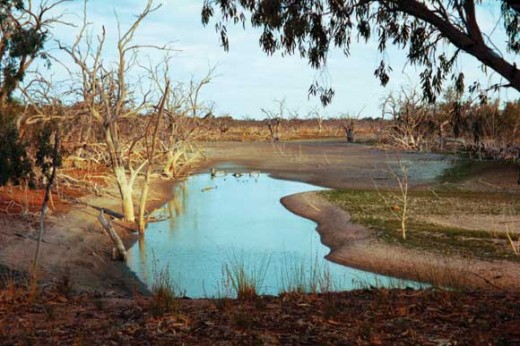 Menindee Lakes —inlet to Lake Cawndilla during drought in 2003 Menindee Lakes —inlet to Lake Cawndilla during drought in 2003
(MDBC Annual Report 2003-04, Photo: L. Palmer)
.
.
.
Further Reading:
.
[1] Jamie Pittock BSc. Hons (Monash), PhD (ANU) is ‘Director of International Programs for the UNESCO Chair in Water Economics and Transboundary Water Governance, Program Leader, Australia and United States – Climate, Energy and Water, US Studies Centre and ANU Water Initiative. Jamie Pittock is Director of International Programs for the UNESCO Chair in Water Economics and Transboundary Water Governance. His current work includes developing research programs that link Australian and southern African expertise to improve management of river basins, green water and agriculture. He is also Program Leader for the Australia and United States – Climate, Energy and Water project of the US Studies Centre and ANU Water Initiative. [Read More].
[2] Darling River Action Group, ^http://www.d-r-a-g.org.au/
[3] Paakantji, ^http://www.curriculumsupport.education.nsw.gov.au/secondary/languages/languages/aboriginal/campfire/stories/paakantji/paakantji_stories.htm
[4] The Wilderness Society (NSW), River Protection Campaigns, ^http://www.wilderness.org.au/campaigns/river-protection
[5] ‘Living Murray, Dying Darling – the year our fish died and Broken Hill cried,’ speech by Joe Flynn, Managing Director, Australian Inland at the Murray Darling Association Annual Conference in Renmark, South Australia 20040902. [Read More]
[6] ‘Great Darling Anabranch to receive much-needed environmental flows‘, Murray-Darling Basin Authority (MDBA), 20100909, ^http://www.mdba.gov.au/media_centre/media_releases/great-darling-anabranch-to-receive-much-needed-environmental-flows, [Read More]
.
– end of article –
Tags: Anabranch, Darling River, Darling River Action Group, Energy and Water, MDBA, Menindee Lakes, Murray-Darling, Murray-Darling Basin Authority, Paakantji, The Wilderness Society, TWS
Posted in Murray Darling (AU), Threats from Farming | No Comments »
Add this post to Del.icio.us - Digg
Wednesday, August 17th, 2011
The following article was initially published by The Wilderness Society (NSW) on its website 20110809. Reproduced with permission from The Wilderness Society (NSW):
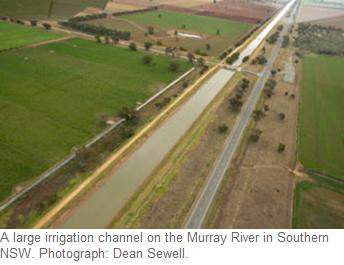
.
Economists say water buybacks can save the Murray-Darling River
A senior economist at The Australian National University (ANU) says that subsidising water infrastructure will not deliver the volumes of water needed to return the Murray-Darling River system to health.
Professor Quentin Grafton from the Crawford School of Economics and Government at the ANU says that despite the Australian Government making commitments to spending $5.8 billion on infrastructure designed to increase water efficiency, this will have little impact on increasing flows through the ailing system.
“That’s probably going to get the government about 500 gigalitres. So to put that in perspective, that’s a fraction of the sorts of numbers we need in terms of volumes for the rivers“, said Prof. Grafton.
“By contrast, if we were to purchase water entitlements from willing sellers, we can get the volumes that we need”.
.
Water Buyback a Sound Approach
.
The Productivity Commission has supported this view, calling for some of the money allocated to infrastructure to be redirected to other initiatives, including water buybacks from willing sellers and support for affected communities.
“A general conclusion is that purchasing water from willing sellers is a sound approach to meeting the Australian Government’s commitment to obtain additional water for the environment. Indeed, it should be the preferred method for recovering water, taking precedence over subsidising investment in water saving infrastructure“, concluded the Commission.
While big irrigation companies continue their scare campaign saying that water buybacks will have a negative economic impact on the agricultural industry, a model proposed by Prof. Grafton concluded that irrigators would be adequately compensated.
“If the $8.9 billion currently budgeted for water reform were spent in a cost effective manner on the purchase of water entitlements rights from willing sellers, and with no arbitrary restrictions on water trade, the Australian government would be able to increase environmental flows by at least 4,000 gigalitres per year, fully compensate irrigators for reduced extractions, and have funds left over.”
This is a much better alternative than committing massive financial resources to infrastructure that will not save the Murray-Darling River.
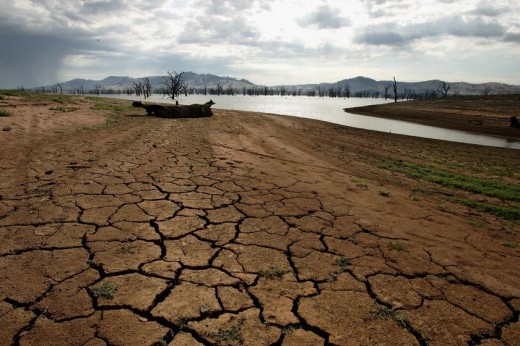 ^http://annamariacom.blogspot.com/2010/10/murray-darling-basin.html ^http://annamariacom.blogspot.com/2010/10/murray-darling-basin.html
.
More Willing Sellers than Tenders
.
Far from being unpopular with many farmers, recent tenders for water buybacks have been oversubscribed, with the majority of sellers only parting with a portion of their entitlements and using the capital raised to improve efficiency or diversify their businesses.
The Australian Government needs to spend the $10 billion of taxpayers’ money allocated to save the river system wisely and ensure the rivers flow, or give the Australian people their money back.
With the health of the rivers and the communities that rely on them at stake, we need economically responsible action that ensures that the rivers keep flowing whilst building stronger, more economically diverse and sustainable rural communities.
Prof. Grafton concluded that, “Unless we spend most of the money on the buying of the water entitlements, we won’t have sufficient flows for the rivers, and that’s a critical point. Because otherwise, we’ll end up spending billions and billions of dollars, we won’t get sufficient volumes for the rivers so we’ll have the problem we’ve gone through in the last few years come back again.”
“The communities will continue to be in a trouble because they won’t get the support that they need, and we’ll end up in a few years time with lots of concrete channels but no water”.
[Source: ^ http://www.wilderness.org.au/regions/new-south-wales/water-buybacks-can-save-the-river]
 Andrew Tatnell, dying River red gums at Chowilla, South Australia in 2004
Photo by Andrew Tatnell
[Source: ^http://www.sauer-thompson.com/archives/opinion/2004/04/ironbar-cracks-again.php] Andrew Tatnell, dying River red gums at Chowilla, South Australia in 2004
Photo by Andrew Tatnell
[Source: ^http://www.sauer-thompson.com/archives/opinion/2004/04/ironbar-cracks-again.php]
.
.
Further Reading:
.
[1] ‘Modelling Water Trade in the Southern Murray-Darling Basin‘, 2004, by The Productivity Commission, ^http://www.pc.gov.au/__data/assets/pdf_file/0003/60474/watertrade.pdf
[2] Murray Darling Basin Authority, ^http://www.mdba.gov.au/basin_plan
[3] ABC Four Corners, background reading on the Murray-Darling Basin Plan, 2011, ^http://www.abc.net.au/4corners/content/2011/s3157128.htm
[4] Hawke Institute, University of South Australia, ^http://www.unisa.edu.au/hawkeinstitute/research/ecosocial/eco-case-study.asp
[5] Murray Darling Association, ^http://www.mda.asn.au/index.cfm?objectid=531DFD7D-D372-0C96-D485B3EAC56F6BF9
[6] Act Now, ^http://www.actnow.com.au/Issues/MurrayDarling_Basin.aspx
[7] Save the Murray, ^http://www.savethemurray.com/
[8] Murray Futures, ^http://www.murrayfutures.sa.gov.au/lower.php
[9] Hurry Save the Murray, ^http://hurrysavethemurray.com/
[10] Murray Darling & the Coorong, ^http://rachel-siewert.greensmps.org.au/content/speech/murray-darling-coorong [extract of speech below]
.
.
[Speech by Rachel Siewert MP, The Australian Greens,Thursday 19th June 2008, ^http://rachel-siewert.greensmps.org.au/content/speech/murray-darling-coorong]
.
“I rise to speak to the motion to take note of the response of the Minister for Climate Change and Water, Senator Wong, representing the Minister for the Environment, Heritage and the Arts, to a question relating to the Murray-Darling river system. Today we had yet another report released on the health of the Murray.
It should come as no surprise, to those of us in particular who have been watching the Murray, that it finds that only one of 23 river valleys of the Murray that were examined had good ecosystem health. Two had moderate ecosystem health. All the rest-that is 20-had poor or very poor ecosystem health. This comes on the back of the report that was released yesterday-well, it was not released; it was leak-released.
On ABC radio the CEO of the Murray-Darling Basin Commission, Wendy Craik, said that the report had not ‘not been released‘; it just had not been released. That report, which had not been released but was not leaked, showed that scientists have said to the government that the Coorong has six months left. They have a six-month window of opportunity, and what is the ministerial council’s response? ‘Oh, we’ll commission some more work into that.’ That just happens to then be available in November. The window of opportunity to fix the Coorong, or to go to some measure to try to remediate the Coorong, closes in October.
.
The report that came out today shows yet again what a parlous state our Murray-Darling river system is in. And what is the government doing about it? Yes, it is buying some water and it is investing in fixing up infrastructure, but on a very ad hoc basis. It is like fiddling while Rome burns-‘We’ll set a new cap; we’ll put in place an authority, at some stage once we get the legislation back in, that will develop a plan for two years.’ But guess what? That plan does not come into effect until 2019. And the reason for that is that the federal government refuses to require New South Wales and Victoria to bring their water sharing plans into line with the basin, into line with the sustainable cap.
That means we will have a lovely plan, we will have planned very well, while the river is dying-because, unless we can curb water use and put into place sustainable water use in the extremely near future, we are going to be watching the river die. We will have a great plan but we will have no water to put back into the river because we are not requiring the states to implement any changes to their plans until 2019. That means no action until 2019, aside from what the government might be able to buy back from willing sellers. It does not do anything about addressing, with a systematic and strategic approach, long-term land use in the Murray-Darling Basin. It does not address what we think is going to be sustainable, not only in trying to address a severely degraded system but also in the face of climate change.
.
The CSIRO reports that are gradually being released as the work is done in each catchment-excellent work, I should say-are showing, as Senator Wong correctly pointed out, that the catchments are facing very severe consequences from the impact of climate change. We have over-allocated all the systems in the Murray-Darling system and we need to be addressing that now, not leaving it for some time off in the future.
.
Some of the ways that we can start addressing the issues around the Coorong now are to start looking at releasing water from the Meningie Lakes, to start looking at accessing some of the water that is currently held in storage in northern New South Wales and to start talking to farmers about loaning water-which, I would suggest, could be repaid with some benefits to the farmers into the future. But one of the issues that I understand is complicating matters there is the control of the New South Wales government over water in the Meningie Lakes. They control the water under 460 gigalitres, and the Commonwealth then gets to have a say in anything above, I think, 660 gigalitres. Guess what? If the level is kept below 660 gigalitres, where the Commonwealth get to have a say, it is all up to New South Wales.
So New South Wales can theoretically keep allocating water from that storage to maintain a level below the amount that the Commonwealth gets to have a say in. And guess what? There is no water to release to the Murray and into the Coorong lakes. If we cannot solve this issue in the Commonwealth’s brave new world of management of the Murray-Darling Basin, there is no hope. We are absolutely in a crisis situation in the Coorong, and yet the Commonwealth is still sitting on its hands and cannot, it appears, get that water from New South Wales and actually do something to save their own icon.”
.
– end of article –
Tags: ANU, Chowilla, Coorong, ecosystem health, Meningie Lakes, Minister for Climate Change and Water, Murray-Darling, Murray-Darling Basin Commission, Productivity Commission, River Red Gums, The Wilderness Society, TWS
Posted in Murray Darling (AU), Threats from Farming | No Comments »
Add this post to Del.icio.us - Digg
Thursday, July 28th, 2011
The following article was initially posted 20090414 by Tigerquoll on CanDoBetter.net:.

The UN position in 1992 on conserving native forests of the world:
.
‘At the 1992 United Nations Conference on Environment and Development (UNCED) the forest issue was among the most controversial, polarizing developing and developed countries.
In Rio de Janeiro, Brazil, intense negotiations among governments at UNCED resulted in the Non-legally Binding Authoritative Statement of Principles for a Global Consensus on the Management, Conservation and Sustainable Development of all Types of Forests, also known as the “Forest Principles”, as well as Chapter 11 of Agenda 21: Combating Deforestation.”
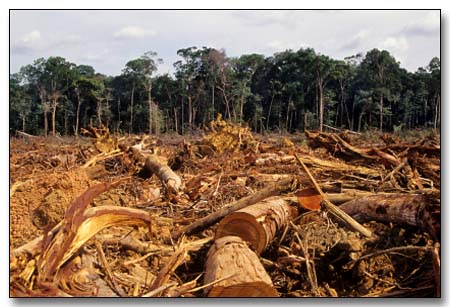
.
..
1992 Report of the United Nations Conference on Environment and Development [UNCED]
(Rio de Janeiro, 3-14 June 1992)
Extract from ‘Annex III’:
[NON-LEGALLY BINDING AUTHORITATIVE STATEMENT OF PRINCIPLES FOR A GLOBAL CONSENSUS ON THE MANAGEMENT, CONSERVATION AND SUSTAINABLE DEVELOPMENT OF ALL TYPES OF FORESTS]
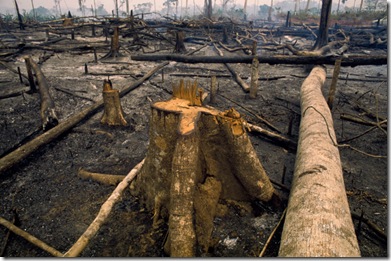
.
PREAMBLE
(a) The subject of forests is related to the entire range of environmental and development issues and opportunities, including the right to socio-economic development on a sustainable basis.
(b) The guiding objective of these principles is to contribute to the management, conservation and sustainable development of forests and to provide or their multiple and complementary functions and uses.
(c) Forestry issues and opportunities should be examined in a holistic and balanced manner within the overall context of environment and development, taking into consideration the multiple functions and uses of forests, including traditional uses, and the likely economic and social stress when these uses are constrained or restricted, as well as the potential for development that sustainable forest management can offer.
(d) These principles reflect a first global consensus on forests. In committing themselves to the prompt implementation of these principles, countries also decide to keep them under assessment for their adequacy with regard to further international cooperation on forest issues.
(e) These principles should apply to all types of forests, both natural and planted, in all geographical regions and climatic zones, including austral, boreal, subtemperate, temperate, subtropical and tropical.
(f) All types of forests embody complex and unique ecological processes which are the basis for their present and potential capacity to provide resources to satisfy human needs as well as environmental values, and as such their sound management and conservation is of concern to the Governments of the countries to which they belong and are of value to local communities and to the environment as a whole.
(g) Forests are essential to economic development and the maintenance of all forms of life.
(h) Recognizing that the responsibility for forest management, conservation and sustainable development is in many States allocated among federal/national, state/provincial and local levels of government, each State, in accordance with its constitution and/or national legislation, should pursue these principles at the appropriate level of government.
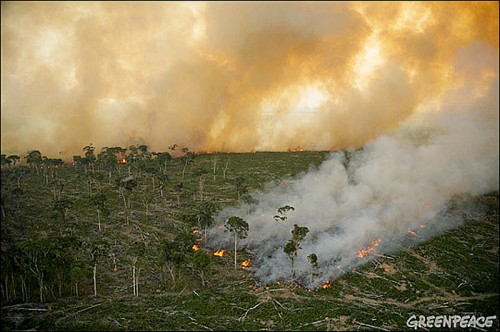
.
PRINCIPLES/ELEMENTS
.
1. (a) States have, in accordance with the Charter of the United Nations and the principles of international law, the sovereign right to exploit their own resources pursuant to their own environmental policies and have the responsibility to ensure that activities within their jurisdiction or control do not cause damage to the environment of other States or of areas beyond the limits of national jurisdiction.
(b) The agreed full incremental cost of achieving benefits associated with forest conservation and sustainable development requires increased international cooperation and should be equitably shared by the international community.
2. (a) States have the sovereign and inalienable right to utilize, manage and develop their forests in accordance with their development needs and level of socio-economic development and on the basis of national policies consistent with sustainable development and legislation, including the conversion of such areas for other uses within the overall socio-economic development plan and based on rational land-use policies.
(b) Forest resources and forest lands should be sustainably managed to meet the social, economic, ecological, cultural and spiritual needs of present and future generations. These needs are for forest products and services, such as wood and wood products, water, food, fodder, medicine, fuel, shelter, employment, recreation, habitats for wildlife, landscape diversity, carbon sinks and reservoirs, and for other forest products. Appropriate measures should be taken to protect forests against harmful effects of pollution, including air-borne pollution, fires, pests and diseases, in order to maintain their full multiple value.
(c) The provision of timely, reliable and accurate information on forests and forest ecosystems is essential for public understanding and informed decision-making and should be ensured.
(d) Governments should promote and provide opportunities for the participation of interested parties, including local communities and indigenous people, industries, labour, non-governmental organizations and individuals, forest dwellers and women, in the development, implementation and planning of national forest policies.
3. (a) National policies and strategies should provide a framework for increased efforts, including the development and strengthening of institutions and programmes for the management, conservation and sustainable development of forests and forest lands.
(b) International institutional arrangements, building on those organizations and mechanisms already in existence, as appropriate, should facilitate international cooperation in the field of forests.
(c) All aspects of environmental protection and social and economic development as they relate to forests and forest lands should be integrated and comprehensive.
4. The vital role of all types of forests in maintaining the ecological processes and balance at the local, national, regional and global levels through, inter alia, their role in protecting fragile ecosystems, watersheds and freshwater resources and as rich storehouses of biodiversity and biological resources and sources of genetic material for biotechnology products, as well as photosynthesis, should be recognized.
5. (a) National forest policies should recognize and duly support the identity, culture and the rights of indigenous people, their communities and other communities and forest dwellers. Appropriate conditions should be promoted for these groups to enable them to have an economic stake in forest use, perform economic activities, and achieve and maintain cultural identity and social organization, as well as adequate levels of livelihood and well-being, through, inter alia, those land tenure arrangements which serve as incentives for the sustainable management of forests.
(b) The full participation of women in all aspects of the management, conservation and sustainable development of forests should be actively promoted.
6. (a) All types of forests play an important role in meeting energy requirements through the provision of a renewable source of bio-energy, particularly in developing countries, and the demands for fuelwood for household and industrial needs should be met through sustainable forest management, afforestation and reforestation. To this end, the potential contribution of plantations of both indigenous and introduced species for the provision of both fuel and industrial wood should be recognized.
(b) National policies and programmes should take into account the relationship, where it exists, between the conservation, management and sustainable development of forests and all aspects related to the production, consumption, recycling and/or final disposal of forest products.
(c) Decisions taken on the management, conservation and sustainable development of forest resources should benefit, to the extent practicable, from a comprehensive assessment of economic and non-economic values of forest goods and services and of the environmental costs and benefits. The development and improvement of methodologies for such evaluations should be promoted.
(d) The role of planted forests and permanent agricultural crops as sustainable and environmentally sound sources of renewable energy and industrial raw material should be recognized, enhanced and promoted. Their contribution to the maintenance of ecological processes, to offsetting pressure on primary/old-growth forest and to providing regional employment and development with the adequate involvement of local inhabitants should be recognized and enhanced.
(e) Natural forests also constitute a source of goods and services, and their conservation, sustainable management and use should be promoted.
7. (a) Efforts should be made to promote a supportive international economic climate conducive to sustained and environmentally sound development of forests in all countries, which include, inter alia, the promotion of sustainable patterns of production and consumption, the eradication of poverty and the promotion of food security.
(b) Specific financial resources should be provided to developing countries with significant forest areas which establish programmes for the conservation of forests including protected natural forest areas. These resources should be directed notably to economic sectors which would stimulate economic and social substitution activities.
8. (a) Efforts should be undertaken towards the greening of the world.
All countries, notably developed countries, should take positive and transparent action towards reforestation, afforestation and forest conservation, as appropriate.
(b) Efforts to maintain and increase forest cover and forest productivity should be undertaken in ecologically, economically and socially sound ways through the rehabilitation, reforestation and re-establishment of trees and forests on unproductive, degraded and deforested lands, as well as through the management of existing forest resources.
(c) The implementation of national policies and programmes aimed at forest management, conservation and sustainable development, particularly in developing countries, should be supported by international financial and technical cooperation, including through the private sector, where appropriate.
(d) Sustainable forest management and use should be carried out in accordance with national development policies and priorities and on the basis of environmentally sound national guidelines. In the formulation of such guidelines, account should be taken, as appropriate and if applicable, of relevant internationally agreed methodologies and criteria.
(e) Forest management should be integrated with management of adjacent areas so as to maintain ecological balance and sustainable productivity.
(f) National policies and/or legislation aimed at management, conservation and sustainable development of forests should include the protection of ecologically viable representative or unique examples of forests, including primary/old-growth forests, cultural, spiritual, historical, religious and other unique and valued forests of national importance.
(g) Access to biological resources, including genetic material, shall be with due regard to the sovereign rights of the countries where the forests are located and to the sharing on mutually agreed terms of technology and profits from biotechnology products that are derived from these resources.
(h) National policies should ensure that environmental impact assessments should be carried out where actions are likely to have significant adverse impacts on important forest resources, and where such actions are subject to a decision of a competent national authority.
9. (a) The efforts of developing countries to strengthen the management, conservation and sustainable development of their forest resources should be supported by the international community, taking into account the importance of redressing external indebtedness, particularly where aggravated by the net transfer of resources to developed countries, as well as the problem of achieving at least the replacement value of forests through improved market access for forest products, especially processed products. In this respect, special attention should also be given to the countries undergoing the process of transition to market economies.
(b) The problems that hinder efforts to attain the conservation and sustainable use of forest resources and that stem from the lack of alternative options available to local communities, in particular the urban poor and poor rural populations who are economically and socially dependent on forests and forest resources, should be addressed by Governments and the international community.
(c) National policy formulation with respect to all types of forests should take account of the pressures and demands imposed on forest ecosystems and resources from influencing factors outside the forest sector, and intersectoral means of dealing with these pressures and demands should be sought.
10. New and additional financial resources should be provided to developing countries to enable them to sustainably manage, conserve and develop their forest resources, including through afforestation, reforestation and combating deforestation and forest and land degradation.
11. In order to enable, in particular, developing countries to enhance their endogenous capacity and to better manage, conserve and develop their forest resources, the access to and transfer of environmentally sound technologies and corresponding know-how on favourable terms, including on concessional and preferential terms, as mutually agreed, in accordance with the relevant provisions of Agenda 21, should be promoted, facilitated and financed, as appropriate.
12. (a) Scientific research, forest inventories and assessments carried out by national institutions which take into account, where relevant, biological, physical, social and economic variables, as well as technological development and its application in the field of sustainable forest management, conservation and development, should be strengthened through effective modalities, including international cooperation. In this context, attention should also be given to research and development of sustainably harvested non-wood products.
(b) National and, where appropriate, regional and international institutional capabilities in education, training, science, technology, economics, anthropology and social aspects of forests and forest management are essential to the conservation and sustainable development of forests and should be strengthened.
(c) International exchange of information on the results of forest and forest management research and development should be enhanced and broadened, as appropriate, making full use of education and training institutions, including those in the private sector.
(d) Appropriate indigenous capacity and local knowledge regarding the conservation and sustainable development of forests should, through institutional and financial support and in collaboration with the people in the local communities concerned, be recognized, respected, recorded, developed and, as appropriate, introduced in the implementation of programmes. Benefits arising from the utilization of indigenous knowledge should therefore be equitably shared with such people.
13. (a) Trade in forest products should be based on non-discriminatory and multilaterally agreed rules and procedures consistent with international trade law and practices. In this context, open and free international trade in forest products should be facilitated.
(b) Reduction or removal of tariff barriers and impediments to the provision of better market access and better prices for higher value-added forest products and their local processing should be encouraged to enable producer countries to better conserve and manage their renewable forest resources.
(c) Incorporation of environmental costs and benefits into market forces and mechanisms, in order to achieve forest conservation and sustainable development, should be encouraged both domestically and internationally.
(d) Forest conservation and sustainable development policies should be integrated with economic, trade and other relevant policies.
(e) Fiscal, trade, industrial, transportation and other policies and practices that may lead to forest degradation should be avoided. Adequate policies, aimed at management, conservation and sustainable development of forests, including, where appropriate, incentives, should be encouraged.
14. Unilateral measures, incompatible with international obligations or agreements, to restrict and/or ban international trade in timber or other forest products should be removed or avoided, in order to attain long-term sustainable forest management.
15. Pollutants, particularly air-borne pollutants, including those responsible for acidic deposition, that are harmful to the health of forest ecosystems at the local, national, regional and global levels should be controlled.’
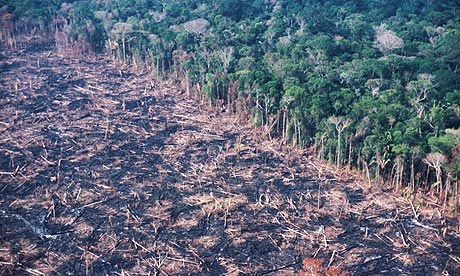
.
.
The UN position in 2007:
.
‘Following nearly 3 years of intense negotiations, starting from UNFF5 and culminating at UNFF7, the Non-Legally Binding Instrument on All types of Forests was adopted on 28 April 2007. The Instrument was adopted by the UN General Assembly (Resolution 62/98) on 17 December 2007.
The purpose of this instrument is:
(a) To strengthen political commitment and action at all levels to implement effectively sustainable management of all types of forests and to achieve the shared global objectives on forests;
(b) To enhance the contribution of forests to the achievement of the internationally agreed development goals, including the Millennium Development Goals, in particular with respect to poverty eradication and environmental sustainability;
(c) To provide a framework for national action and international cooperation.’
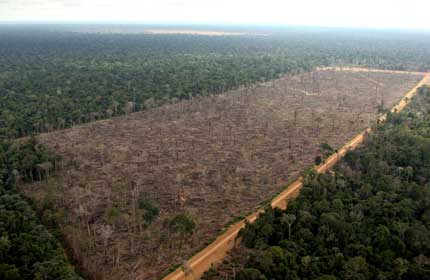
– end of article –
.
.
Rainforest Reality, 2011:
.
‘Deforestation in Brazil’s Amazon Region Increases 400% in One Year’ [ May 2011]
[20110520, hispanicallyspeakingnews.com]
.
‘Brazil is reporting a dramatic increase in deforestation in the Amazon that has the country’s environmental protectionists and some government officials troubled. In just one year – March/April of 2010 -2011 – Brazil’s Amazon has seen a 400 percent increase in the amount of acres that have undergone deforestation – 25,451 acres to 146,533, according to satellite images from the Brazilian space research institute.
Environmental protectionists believe the increased demand for cattle and soy are behind the decision to clear so many acres, while other blame the government for not being hesitant in regards to laws to regulate deforestation. The country’s Environmental Minister Izabella Teixeira said she was troubled to see the satellite images, and said the government would establishing a special panel to address the matter.
Currently, Brazilian law states that 80 percent of the land in the Amazon region must remain forested, and that has been in place since 1934. Still, deforestation advocates claim additional clearing is needed. In the state of Mato Grosso, deforestation occurs in large part to make room for soybean production.’
.
[Source: ^ http://www.hispanicallyspeakingnews.com/notitas-de-noticias/details/deforestation-in-brazils-amazon-region-increases-400-in-one-year/7782/, accessed 20110728]
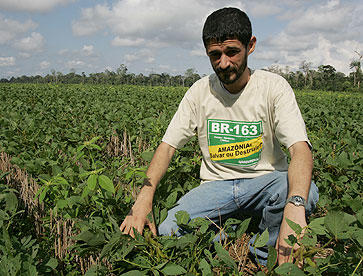
Editor’s comment: ‘This the consequence of ‘non-legally binding UN ‘Forest Principles’.’
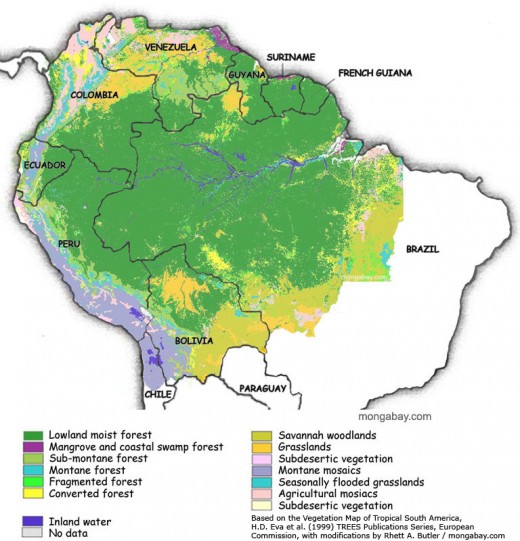
.
.
Read More:
.
[1] United Nations Forum on Forests, ^http://www.un.org/esa/forests/
[2] Mongabay.com, ^http://www.mongabay.com/brazil.html
[3] Greenpeace.org, ^http://www.greenpeace.org/international/en/press/releases/second-largest-rate-of-amazon/
[4] Greenpeace campaign to save the Amazon, ^http://www.greenpeace.org/international/en/campaigns/forests/amazon/
[5] ‘Deforestation in decline but rate remains alarming, UN agency says‘, UN News Centre, ^http://www.un.org/apps/news/story.asp?NewsID=34195
[6] ‘REDD’, The United Nations Collaborative Programme on Reducing Emissions from Deforestation and Forest Degradation in Developing Countries, ^http://www.un-redd.org/
[7] ‘UN: $40bn a year could halve deforestation worldwide‘, by Will Nichols, 20110606, Business Green, ^http://www.businessgreen.com/bg/news/2076417/-usd40bn-halve-deforestation-worldwide
.
(above references accessed 20110728)
.
– end of article –
Tags: Agenda 21: Combating Deforestation, Amazon forest, deforestation, Forest Principles, old growth conservation, old growth forest, Rainforest Reality, soybean, tigerquoll, U.N. Principles, UNCED, UNFF
Posted in Amazon (BR), Threats from Deforestation, Threats from Farming | No Comments »
Add this post to Del.icio.us - Digg
Friday, July 22nd, 2011
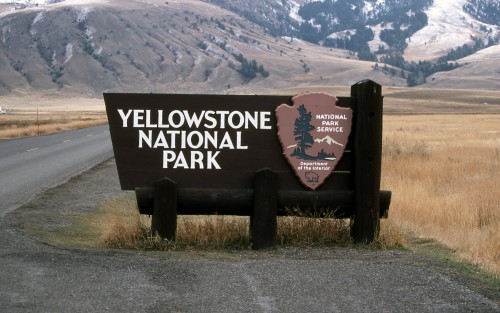 A proper ‘National Park” – Yellowstone National Park, USA A proper ‘National Park” – Yellowstone National Park, USA
© Photo by Jim Peaco, October 1992
[Source: http://www.longislandpress.com/wp-content/uploads/2011/07/14566-1.jpg]
.
One hundred and thirty nine years ago in 1872, Yellowstone National Park was established in the United States of America, leading the world in national conservation..
Australia supposedly followed suit quickly afterwards in 1879, declaring The National Park just south of Sydney the second national park in the world. It was renamed Royal National Park following Queen Elizabeth II’s visit in 1954.
But it is one thing to be seen to be following America in environmental leadership. It is publicly misleading to be disingenuous about ‘national‘ environmental protection.
 A ‘vulnerable’ Royal National Park (New South Wales, Australia)…
. A ‘vulnerable’ Royal National Park (New South Wales, Australia)…
.
National Parks in New South Wales are currently subject to the whims of incumbent State governments (both Labor and Liberal) and mining vested interests with such demands as to explore coal seam gas mining using fracking and chemical contamination from the likes of Apex Energy and Peabody Pacific’s joint Metropolitan Mine near Helensburgh in 2010.
National parks are typically large natural areas of land that are protected because they have unspoilt landscapes and a diverse number of native plants and animals. This means that commercial activities such as farming are prohibited and human activity is strictly monitored. The purpose of the ‘national parks’ concept is to protect native flora and fauna and their habitat.
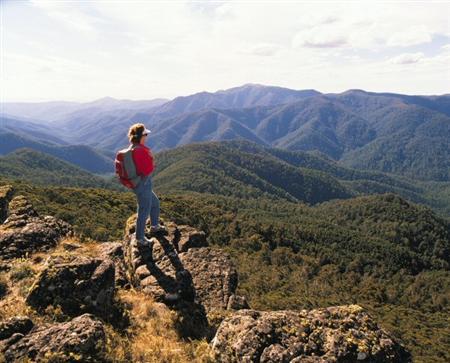 Victorian Alps Victorian Alps
.
Disturbingly, the powers that be in National Parks have grown a mindset that national parks are created primarily not for altruistic genuine conservation but for tourism – human use, benefit and exploitation. The sell is that national parks “are also there so Australians and foreign visitors can enjoy and learn about our unique environment, heritage and culture.”
Australia has over 500 national parks covering some 28 million hectares accounting for 4% of Australia’s land mass. But similarly disturbing is that the Australia legal concept of a ‘national park’ is one typically managed not by the national government, but a custodial responsibility delegated to the States and Territories of Australia. This means that across Australia, national parks are a hollow label for ‘reserve’, or in the case of Victoria’s Alpine National Park, an endless free cow paddock!
 Cattle in the Alpine National Park?
© Photo Trevor Pinder Herald Sun 20110412 Cattle in the Alpine National Park?
© Photo Trevor Pinder Herald Sun 20110412
.
The state/territory custodial role for national parks is a left-over legacy from pre-Federation colonial Australia of the Nineteenth Century, in much the same way the Crown Land is a leftover legacy from when the Australian colonies were subservient to Britain. And sure enough, the management records demonstrate that the spirit of national park protection has not been respected by the state and territory custodial governments.
National Park ‘protection’ in the United States has national clout. But in Australia the term is politically expedient and superficial. This has caused the conservation movement to increasingly look to UNESCO World Heritage, because state and territory governments cannoit be trusted. ‘National park’ status has become meaningless. Just consider the Kakadu, Kosciuszko, and the Great Barrier Reef national parks and their abuse and mismanagement legacies!
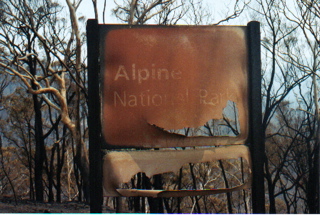 Alpine National Park
10,000 hectares was allowed to burn in 2003
~ so much for National Park ‘protection’, more like ‘abandonment’. Alpine National Park
10,000 hectares was allowed to burn in 2003
~ so much for National Park ‘protection’, more like ‘abandonment’.
.
.
Media Release by the National Parks Association of NSW:
[22 July 2011]
.
‘National Parks to be given national status’
.
National Parks Association of NSW CEO, Kevin Evans, has welcomed moves by Federal environment minister Tony Burke to add Commonwealth protection to Australia’s national parks.
“Stronger Federal protection for national parks is a groundbreaking move that will ensure the long-term integrity of Australia’s most loved natural places and vital habitat for threatened plants and animals,” Mr. Evans said.
“It will also make sure that politically motivated interference in park protection, including proposals for inappropriate tourism infrastructure, mining, cattle grazing and hunting will be more difficult in the future.
“We need to be clear that such proposals are not in the national interest,” Mr. Evans said. “Our protected areas are part of much bigger systems working at a landscape scale as the corner stone of Australia’s biodiversity conservation strategy.”
Speaking at the Sydney Institute on Thursday evening, Mr. Burke said “that there was a principle that once an area was protected there shall be no backward steps”.
He referred to the move by the Victorian government to return cattle to the Alpine National Parks earlier this year as treating a national park like a farm.
“Importantly, if implemented, this proposal would allow Australia to honour its commitment to international treaties designed to protect the world’s natural heritage” Mr. Evans said.
“It won’t change the way national parks are managed but as the minister says, it will make sure that there will be ‘no backward steps’ in that management.
“Most people already assume that national parks have national protection, as they do in most countries of the world. But almost all of our most important natural areas are actually set up and managed under the laws of each state and territory.”
Minister Burke announced last night that he has written to all states and territories seeking their views on a plan to amend federal laws to better protect national parks.
NPA encourages the NSW government to cooperate with the Federal environment minister on his proposal.
“Under the proposed federal law, states will still be in control of setting park boundaries, and there will be no change to existing activities in parks,” said Mr. Evans.
Mr. Evans said,
“What it does mean is that the protection offered by state laws will be backed up by national law.”
Our national parks will be truly part of our national heritage, securely protected by all Australians, for all Australians, for all time.
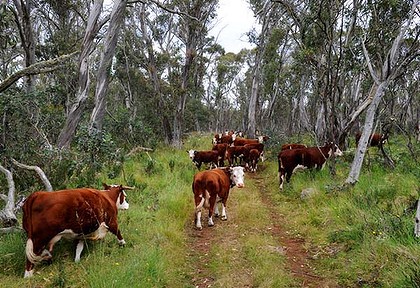
.
.
Editor’s comments:
This revelation confirms that Australians have been hoodwinked about ‘National Park Protection’ since 1879.
It one of the biggest greenwashing cons in Australian history. National Parks are but a convenient propaganda label until alternative land use demands are proposed.
The message is that the States and Territories simply cannot be trusted with Australia’s valuable natural heritage.
So if such jurisdictions are so unrepresentative of Australian values, then why do the States and Territories continue to exist?
 Sunrise on Mount Feathertop, Alpine National Park, Victoria
© http://good-wallpapers.com/places/4689. Sunrise on Mount Feathertop, Alpine National Park, Victoria
© http://good-wallpapers.com/places/4689.
.
.
Background:
.
‘High country ought stay a cattle no-go zone’
by Geoff Mosley, 20110308, The Age
.
‘The Baillieu government’s decision to reintroduce cattle into the Alpine National Park not only snubs 80 years of research highlighting the environmental damage they can do, it also undermines co-operative management of Australia’s alpine parks. This move was undertaken without any consultation with the federal government and, since the Alpine National Park is on the National Heritage List, all eyes are on whether Environment Minister Tony Burke will intervene to protect the area’s nationally significant natural heritage values.
 Victorian Premier, Ted Ballieu
© Sunday Herald Sun, 20110424 Victorian Premier, Ted Ballieu
© Sunday Herald Sun, 20110424
.
In deciding, Burke must take into account strong opposition to the Baillieu government’s move from the Australian Academy of Science and the World Commission on Protected Areas. These organisations have pointed to the bad example it would set when more than 3000 people attend the World National Parks Congress in Melbourne in 2014.
The planned ‘‘study’’ was also criticised by Melbourne University’s School of Land and Environment, whose acting head, associate professor Gerd Bossinger, said in an email: ‘‘much of the work being proposed has already been done’’. This response elicited a threat from the Baillieu government over millions of dollars in research funding.
Burke should also consider the damage that Victoria’s action would do to the co-ordinated approach to interstate management of the alpine parks, which has operated since 1986.
The states have been in charge of public land, including national parks, which by then had been established in several states, since Federation in 1901. Federation also introduced a possible role for the federal government in encouraging co-operative endeavours in heritage protection.
Co-operation did not come easily. The first initiative for a cross-state national park in the Alps came from the environment movement.
But, in 1943, the Victorian government rejected the proposed ‘Snowy-Indi National Park‘, embracing parts of the NSW (17,200 ha) and Victoria’s high country (22,000 ha), because of the ‘‘dangers to which large areas of country would be exposed by prohibiting occupation’’ – whatever that meant.
Instead the individual states established separate protected areas in their territories – Kosciusko State Park in 1944 (which became Kosciusko National Park in 1967), Gudgenby Nature Reserve in 1979 (became Namadgi National Park in 1984), and the Alpine National Park (formed from several disparate parks) in 1989.
The case for co-operative management of these adjacent alpine parks was obvious but who would initiate it?
The potential for Commonwealth leadership in such an enterprise was greatly increased in the 1970s with the passage of legislation to protect the national estate and with Australia’s ratification in 1974 of the World Heritage Convention. Apart from Queensland’s Great Barrier Reef and south-west Tasmania, there appeared to be no part of Australia more deserving of such a federal commitment than the Alps.
A clear case in point was the need for a uniform approach to alpine grazing. NSW ended the practice in Kosciusko National Park in 1969. The ACT followed suit. But the Victorian government dithered. So in 1984, I, as then director of the Australian Conservation Foundation, took 15 Victorian MPs on a tour of Kosciusko National Park. The visitors were so impressed by the recovery of the land after the removal of grazing that they agreed on a ‘‘Memorandum of Understanding for Co-operative Management of the Australian Alps National Parks’’, signed on July 15, 1986.
After an extensive review, in 2006 the Victorian government terminated the last of several of grazing licences in the Alpine National Park, bringing the state into line with NSW and the ACT. The Baillieu government’s reintroduction of grazing puts this hard-won co-operation in jeopardy.
Tony Burke’s decision also has consequences for the fate of the world heritage-listing proposal, in limbo since prime minister Bob Hawke announced in 1989 that the Australian Alps would be assessed.
World heritage listing of the Alps and adjacent forests – the ‘‘sea to snow concept’’ – would give the federal government enhanced power to act as Hawke did in 1983 to stop the Franklin Dam in Tasmania’s Wilderness World Heritage Area. Five reports later and nothing has happened. Meanwhile, the presence of cattle in the Alpine National Park could mean that a nomination would fail the ‘‘integrity’’ test for listing.
Burke has an opportunity to not only protect the Alpine National Park but to advance the overall cause of national heritage protection. If the word ‘‘national’’ means anything, he must do the right thing by the people of Australia and send the cattle back down the hill.’
– – – – – – – – – –
[Geoff Mosley has been involved with establishing and management national parks in the alpine areas of ACT, New South Wales and Victoria for 50 years. He was chief executive of the Australian Conservation Foundation from 1973 to 1986 and remains a member of the ACF council.]

.
.
.
Further Reading:
.
[1] ‘Burke demands a halt to alpine cattle grazing‘, 20110318, ABC Rural, ^http://www.abc.net.au/rural/news/content/201103/s3167854.htm
[2] ‘High country ought stay a cattle no-go zone‘, by Geoff Mosley, 20110308, ^http://www.smh.com.au/opinion/high-country-ought-stay-a-cattle-nogo-zone-20110307-1bka1.html
[3] ‘ Cattle Don’t Belong in Parks‘, Victorian National Parks Association ^ http://vnpa.org.au/page/bushwalking-and-activities/events/public-meeting-_-cattle-don%27t-belong-in-parks
[4] ‘ Coal Seam Gas Mining Threatens NSW and Australia‘, ^ http://www.stopcoalseamgas.com/helensburgh.php
[5] ‘ Wildlife under threat from shooters in NSW‘ (National Parks), ^ http://www.animalsaustralia.org/take_action/wildlife-under-threat-from-shooters–in-NSW/
[6] ‘ Uranium mining in Kakadu National Park‘, ^ http://en.wikipedia.org/wiki/Uranium_mining_in_Kakadu_National_Park
[7] ‘ Great Barrier Reef Environmental Threats‘ ^ http://www.workincairns.com/great-barrier-reef/environmental-threats.asp
[8] ‘ Human Impact on the Great Barrier Reef‘, University of Michigan, ^ http://sitemaker.umich.edu/gc2sec7labgroup3/pollution
.
(All references accessed 20110722)
.
22 July 2011
National Parks to be given national status
National Parks Association of NSW CEO, Kevin Evans, has welcomed moves by Federal environment minister Tony Burke to add Commonwealth protection to Australia’s national parks.
“Stronger Federal protection for national parks is a groundbreaking move that will ensure the long-term integrity of Australia’s most loved natural places and vital habitat for threatened plants and animals,” Mr. Evans said.
“It will also make sure that politically motivated interference in park protection, including proposals for inappropriate tourism infrastructure, mining, cattle grazing and hunting will be more difficult in the future.
“We need to be clear that such proposals are not in the national interest,” Mr. Evans said. “Our protected areas are part of much bigger systems working at a landscape scale as the corner stone of Australia’s biodiversity conservation strategy.”
Speaking at the Sydney Institute on Thursday evening, Mr. Burke said “that there was a principle that once an area was protected there shall be no backward steps”. He referred to the move by the Victorian government to return cattle to the Alpine National Parks earlier this year as treating a national park like a farm.
“Importantly, if implemented, this proposal would allow Australia to honour its commitment to international treaties designed to protect the world’s natural heritage” Mr. Evans said.
“It won’t change the way national parks are managed but as the minister says, it will make sure that there will be ‘no backward steps’ in that management.
“Most people already assume that national parks have national protection, as they do in most countries of the world. But almost all of our most important natural areas are actually set up and managed under the laws of each state and territory.”
Minister Burke announced last night that he has written to all states and territories seeking their views on a plan to amend federal laws to better protect national parks.
NPA encourages the NSW government to cooperate with the Federal environment minister on his proposal.
“Under the proposed federal law, states will still be in control of setting park boundaries, and there will be no change to existing activities in parks,” said Mr. Evans.
Mr. Evans said, “What it does mean is that the protection offered by state laws will be backed up by national law. Our national parks will be truly part of our national heritage, securely protected by all Australians, for all Australians, for all time.
“It will be good for nature protection and good for ecologically sustainable tourism,” said Mr. Evans.
Tags: Alpine National Park, Baillieu government, Cattle in the Alpine National Park, Cattle no-go zone, national parks, National Parks Association of NSW, NPA, Tony Burke, Victoria's High Country, World National Parks Congress 2014
Posted in Australian Alps (AU), Threats from Farming, Threats from Greenwashing, Threats from Mining, Threats from Tourism and Recreation | No Comments »
Add this post to Del.icio.us - Digg
|
|
 A ‘paddock tree’ in Australia – valued by farmers for their livestock shade
A ‘paddock tree’ in Australia – valued by farmers for their livestock shade A 19th Century farm meadow in Northern Ireland
Ulster American Folk Park, Castletown, Northern Ireland
(Photo by Editor 20060904, free in public domain, click photo to enlarge)
A 19th Century farm meadow in Northern Ireland
Ulster American Folk Park, Castletown, Northern Ireland
(Photo by Editor 20060904, free in public domain, click photo to enlarge)
 A classic vision of the bucolic English countryside
– where centuries of native heritage, agrarian culture and constant rainfall…permit.
A classic vision of the bucolic English countryside
– where centuries of native heritage, agrarian culture and constant rainfall…permit.
 The decidedly browner, drier reality of Australia’s fragile disappearing native vegetation
Nature on the run: Hundreds of hectares of native animal habitat is bulldozed for a new housing development in Perth’s outer suburbs this year.
(Source: Perth Now, Photo by World Wildlife Fund, Australia 2009)
The decidedly browner, drier reality of Australia’s fragile disappearing native vegetation
Nature on the run: Hundreds of hectares of native animal habitat is bulldozed for a new housing development in Perth’s outer suburbs this year.
(Source: Perth Now, Photo by World Wildlife Fund, Australia 2009)
 ‘Wivenhoe Park, Essex’
by 19th Century English Romantic painter John Constable
‘Wivenhoe Park, Essex’
by 19th Century English Romantic painter John Constable
 The colonial conversion of Australia
The colonial conversion of Australia
 Once was a Shade Tree, once was a Forest
Now a dead reminder of self-righteous colonial exploitation
(Photo: Kate Sherren)
Once was a Shade Tree, once was a Forest
Now a dead reminder of self-righteous colonial exploitation
(Photo: Kate Sherren)















































